Tesla's Strategic Audit and Competitive Analysis
VerifiedAdded on 2020/10/22
|22
|7647
|128
AI Summary
This assignment provides a detailed strategic audit of Tesla, including a review of the company's electric vehicle market strategy, a competitor comparison with other major automotive companies, and a Porter's value chain analysis. The report also includes a discussion on Tesla's corporate strategy, innovation in EVs, and stakeholder theory. It also explores the benefits and considerations of electricity as a vehicle fuel, and provides insights into Tesla's future plans, including the Giga factory's success and expanded Model 3 production.
Contribute Materials
Your contribution can guide someone’s learning journey. Share your
documents today.

STRATEGY AND
COMPETITION
COMPETITION
Secure Best Marks with AI Grader
Need help grading? Try our AI Grader for instant feedback on your assignments.
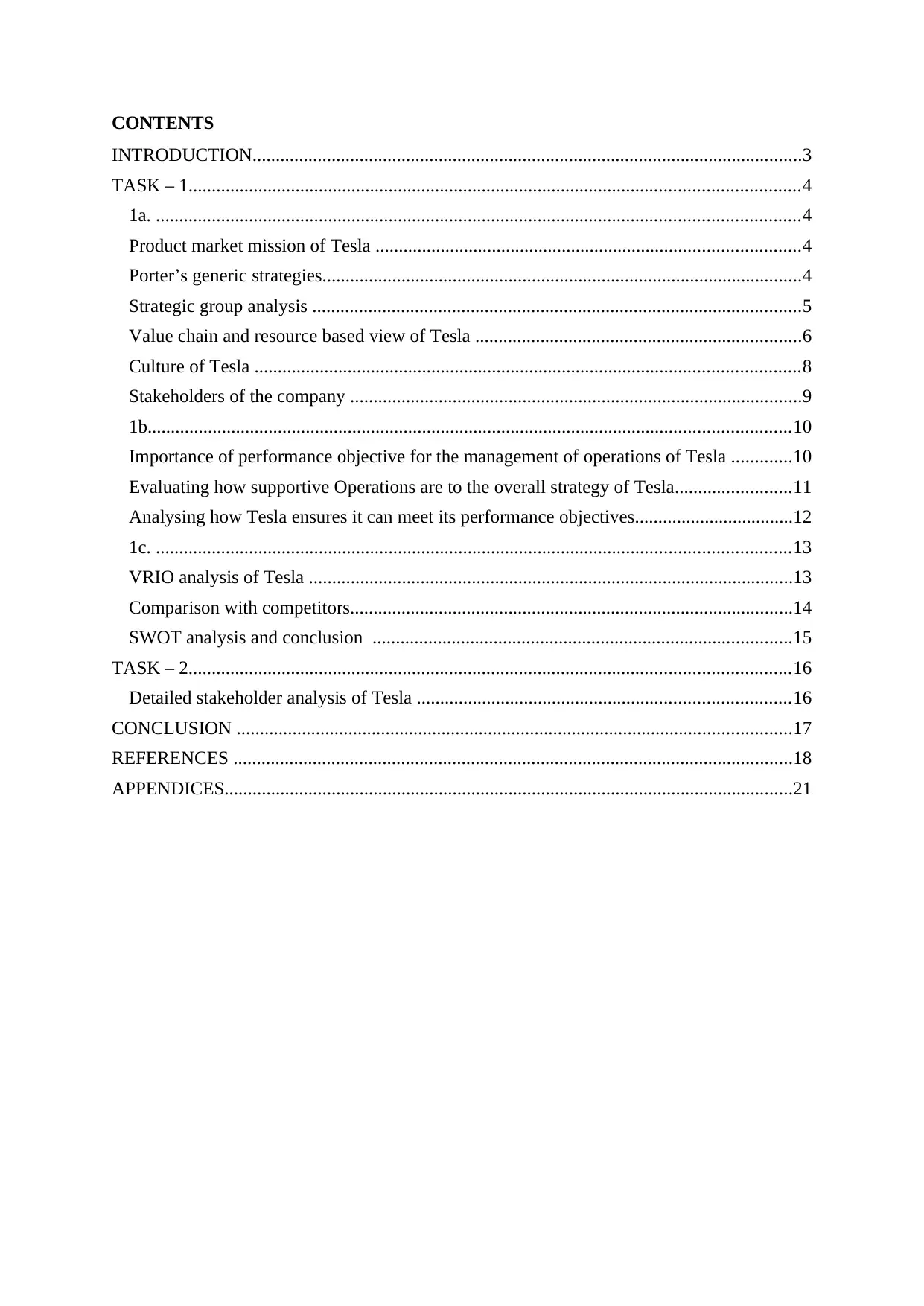
CONTENTS
INTRODUCTION......................................................................................................................3
TASK – 1...................................................................................................................................4
1a. ..........................................................................................................................................4
Product market mission of Tesla ...........................................................................................4
Porter’s generic strategies.......................................................................................................4
Strategic group analysis .........................................................................................................5
Value chain and resource based view of Tesla ......................................................................6
Culture of Tesla .....................................................................................................................8
Stakeholders of the company .................................................................................................9
1b..........................................................................................................................................10
Importance of performance objective for the management of operations of Tesla .............10
Evaluating how supportive Operations are to the overall strategy of Tesla.........................11
Analysing how Tesla ensures it can meet its performance objectives..................................12
1c. ........................................................................................................................................13
VRIO analysis of Tesla ........................................................................................................13
Comparison with competitors...............................................................................................14
SWOT analysis and conclusion ..........................................................................................15
TASK – 2.................................................................................................................................16
Detailed stakeholder analysis of Tesla ................................................................................16
CONCLUSION .......................................................................................................................17
REFERENCES ........................................................................................................................18
APPENDICES..........................................................................................................................21
INTRODUCTION......................................................................................................................3
TASK – 1...................................................................................................................................4
1a. ..........................................................................................................................................4
Product market mission of Tesla ...........................................................................................4
Porter’s generic strategies.......................................................................................................4
Strategic group analysis .........................................................................................................5
Value chain and resource based view of Tesla ......................................................................6
Culture of Tesla .....................................................................................................................8
Stakeholders of the company .................................................................................................9
1b..........................................................................................................................................10
Importance of performance objective for the management of operations of Tesla .............10
Evaluating how supportive Operations are to the overall strategy of Tesla.........................11
Analysing how Tesla ensures it can meet its performance objectives..................................12
1c. ........................................................................................................................................13
VRIO analysis of Tesla ........................................................................................................13
Comparison with competitors...............................................................................................14
SWOT analysis and conclusion ..........................................................................................15
TASK – 2.................................................................................................................................16
Detailed stakeholder analysis of Tesla ................................................................................16
CONCLUSION .......................................................................................................................17
REFERENCES ........................................................................................................................18
APPENDICES..........................................................................................................................21
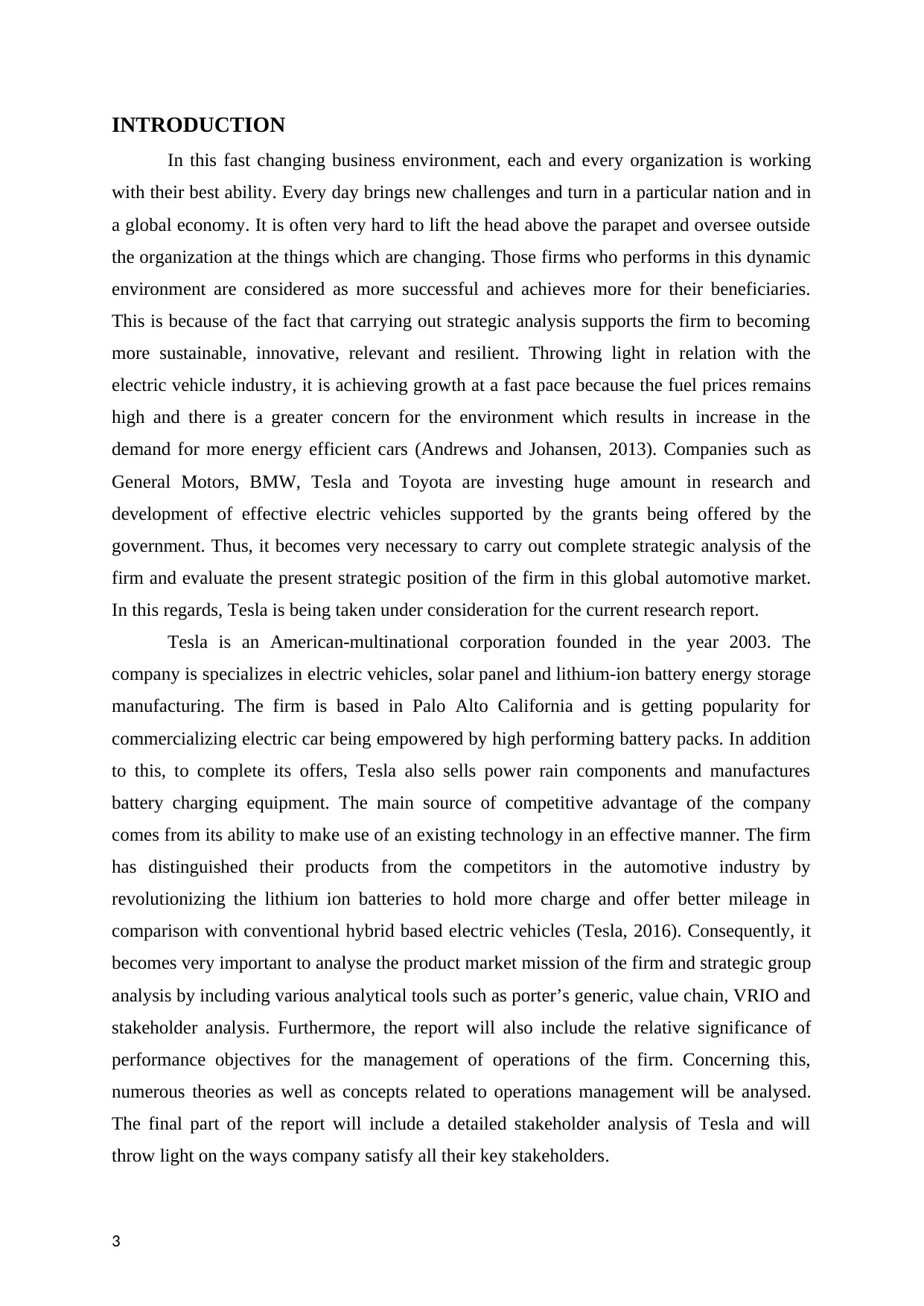
INTRODUCTION
In this fast changing business environment, each and every organization is working
with their best ability. Every day brings new challenges and turn in a particular nation and in
a global economy. It is often very hard to lift the head above the parapet and oversee outside
the organization at the things which are changing. Those firms who performs in this dynamic
environment are considered as more successful and achieves more for their beneficiaries.
This is because of the fact that carrying out strategic analysis supports the firm to becoming
more sustainable, innovative, relevant and resilient. Throwing light in relation with the
electric vehicle industry, it is achieving growth at a fast pace because the fuel prices remains
high and there is a greater concern for the environment which results in increase in the
demand for more energy efficient cars (Andrews and Johansen, 2013). Companies such as
General Motors, BMW, Tesla and Toyota are investing huge amount in research and
development of effective electric vehicles supported by the grants being offered by the
government. Thus, it becomes very necessary to carry out complete strategic analysis of the
firm and evaluate the present strategic position of the firm in this global automotive market.
In this regards, Tesla is being taken under consideration for the current research report.
Tesla is an American-multinational corporation founded in the year 2003. The
company is specializes in electric vehicles, solar panel and lithium-ion battery energy storage
manufacturing. The firm is based in Palo Alto California and is getting popularity for
commercializing electric car being empowered by high performing battery packs. In addition
to this, to complete its offers, Tesla also sells power rain components and manufactures
battery charging equipment. The main source of competitive advantage of the company
comes from its ability to make use of an existing technology in an effective manner. The firm
has distinguished their products from the competitors in the automotive industry by
revolutionizing the lithium ion batteries to hold more charge and offer better mileage in
comparison with conventional hybrid based electric vehicles (Tesla, 2016). Consequently, it
becomes very important to analyse the product market mission of the firm and strategic group
analysis by including various analytical tools such as porter’s generic, value chain, VRIO and
stakeholder analysis. Furthermore, the report will also include the relative significance of
performance objectives for the management of operations of the firm. Concerning this,
numerous theories as well as concepts related to operations management will be analysed.
The final part of the report will include a detailed stakeholder analysis of Tesla and will
throw light on the ways company satisfy all their key stakeholders.
3
In this fast changing business environment, each and every organization is working
with their best ability. Every day brings new challenges and turn in a particular nation and in
a global economy. It is often very hard to lift the head above the parapet and oversee outside
the organization at the things which are changing. Those firms who performs in this dynamic
environment are considered as more successful and achieves more for their beneficiaries.
This is because of the fact that carrying out strategic analysis supports the firm to becoming
more sustainable, innovative, relevant and resilient. Throwing light in relation with the
electric vehicle industry, it is achieving growth at a fast pace because the fuel prices remains
high and there is a greater concern for the environment which results in increase in the
demand for more energy efficient cars (Andrews and Johansen, 2013). Companies such as
General Motors, BMW, Tesla and Toyota are investing huge amount in research and
development of effective electric vehicles supported by the grants being offered by the
government. Thus, it becomes very necessary to carry out complete strategic analysis of the
firm and evaluate the present strategic position of the firm in this global automotive market.
In this regards, Tesla is being taken under consideration for the current research report.
Tesla is an American-multinational corporation founded in the year 2003. The
company is specializes in electric vehicles, solar panel and lithium-ion battery energy storage
manufacturing. The firm is based in Palo Alto California and is getting popularity for
commercializing electric car being empowered by high performing battery packs. In addition
to this, to complete its offers, Tesla also sells power rain components and manufactures
battery charging equipment. The main source of competitive advantage of the company
comes from its ability to make use of an existing technology in an effective manner. The firm
has distinguished their products from the competitors in the automotive industry by
revolutionizing the lithium ion batteries to hold more charge and offer better mileage in
comparison with conventional hybrid based electric vehicles (Tesla, 2016). Consequently, it
becomes very important to analyse the product market mission of the firm and strategic group
analysis by including various analytical tools such as porter’s generic, value chain, VRIO and
stakeholder analysis. Furthermore, the report will also include the relative significance of
performance objectives for the management of operations of the firm. Concerning this,
numerous theories as well as concepts related to operations management will be analysed.
The final part of the report will include a detailed stakeholder analysis of Tesla and will
throw light on the ways company satisfy all their key stakeholders.
3
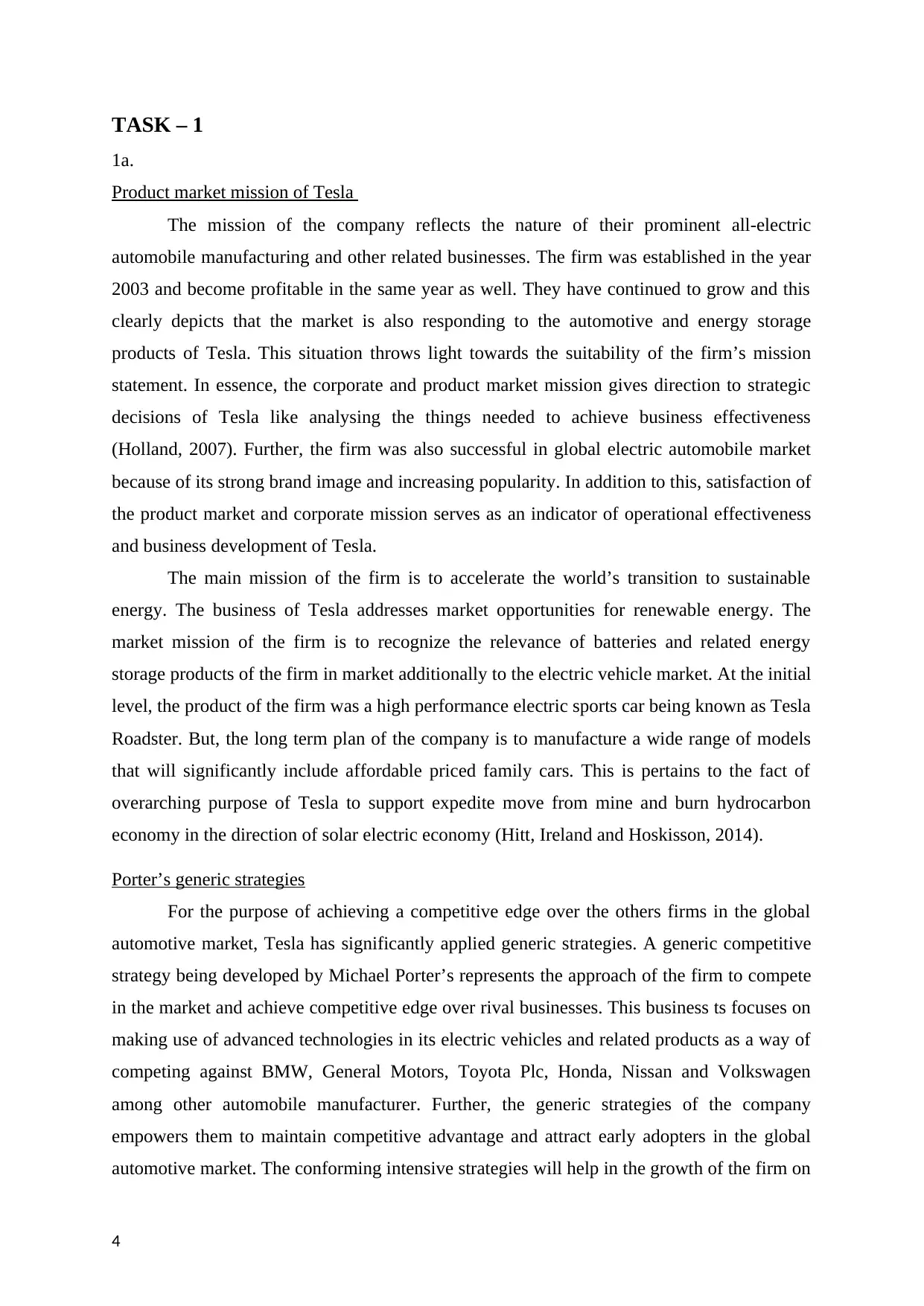
TASK – 1
1a.
Product market mission of Tesla
The mission of the company reflects the nature of their prominent all-electric
automobile manufacturing and other related businesses. The firm was established in the year
2003 and become profitable in the same year as well. They have continued to grow and this
clearly depicts that the market is also responding to the automotive and energy storage
products of Tesla. This situation throws light towards the suitability of the firm’s mission
statement. In essence, the corporate and product market mission gives direction to strategic
decisions of Tesla like analysing the things needed to achieve business effectiveness
(Holland, 2007). Further, the firm was also successful in global electric automobile market
because of its strong brand image and increasing popularity. In addition to this, satisfaction of
the product market and corporate mission serves as an indicator of operational effectiveness
and business development of Tesla.
The main mission of the firm is to accelerate the world’s transition to sustainable
energy. The business of Tesla addresses market opportunities for renewable energy. The
market mission of the firm is to recognize the relevance of batteries and related energy
storage products of the firm in market additionally to the electric vehicle market. At the initial
level, the product of the firm was a high performance electric sports car being known as Tesla
Roadster. But, the long term plan of the company is to manufacture a wide range of models
that will significantly include affordable priced family cars. This is pertains to the fact of
overarching purpose of Tesla to support expedite move from mine and burn hydrocarbon
economy in the direction of solar electric economy (Hitt, Ireland and Hoskisson, 2014).
Porter’s generic strategies
For the purpose of achieving a competitive edge over the others firms in the global
automotive market, Tesla has significantly applied generic strategies. A generic competitive
strategy being developed by Michael Porter’s represents the approach of the firm to compete
in the market and achieve competitive edge over rival businesses. This business ts focuses on
making use of advanced technologies in its electric vehicles and related products as a way of
competing against BMW, General Motors, Toyota Plc, Honda, Nissan and Volkswagen
among other automobile manufacturer. Further, the generic strategies of the company
empowers them to maintain competitive advantage and attract early adopters in the global
automotive market. The conforming intensive strategies will help in the growth of the firm on
4
1a.
Product market mission of Tesla
The mission of the company reflects the nature of their prominent all-electric
automobile manufacturing and other related businesses. The firm was established in the year
2003 and become profitable in the same year as well. They have continued to grow and this
clearly depicts that the market is also responding to the automotive and energy storage
products of Tesla. This situation throws light towards the suitability of the firm’s mission
statement. In essence, the corporate and product market mission gives direction to strategic
decisions of Tesla like analysing the things needed to achieve business effectiveness
(Holland, 2007). Further, the firm was also successful in global electric automobile market
because of its strong brand image and increasing popularity. In addition to this, satisfaction of
the product market and corporate mission serves as an indicator of operational effectiveness
and business development of Tesla.
The main mission of the firm is to accelerate the world’s transition to sustainable
energy. The business of Tesla addresses market opportunities for renewable energy. The
market mission of the firm is to recognize the relevance of batteries and related energy
storage products of the firm in market additionally to the electric vehicle market. At the initial
level, the product of the firm was a high performance electric sports car being known as Tesla
Roadster. But, the long term plan of the company is to manufacture a wide range of models
that will significantly include affordable priced family cars. This is pertains to the fact of
overarching purpose of Tesla to support expedite move from mine and burn hydrocarbon
economy in the direction of solar electric economy (Hitt, Ireland and Hoskisson, 2014).
Porter’s generic strategies
For the purpose of achieving a competitive edge over the others firms in the global
automotive market, Tesla has significantly applied generic strategies. A generic competitive
strategy being developed by Michael Porter’s represents the approach of the firm to compete
in the market and achieve competitive edge over rival businesses. This business ts focuses on
making use of advanced technologies in its electric vehicles and related products as a way of
competing against BMW, General Motors, Toyota Plc, Honda, Nissan and Volkswagen
among other automobile manufacturer. Further, the generic strategies of the company
empowers them to maintain competitive advantage and attract early adopters in the global
automotive market. The conforming intensive strategies will help in the growth of the firm on
4
Secure Best Marks with AI Grader
Need help grading? Try our AI Grader for instant feedback on your assignments.
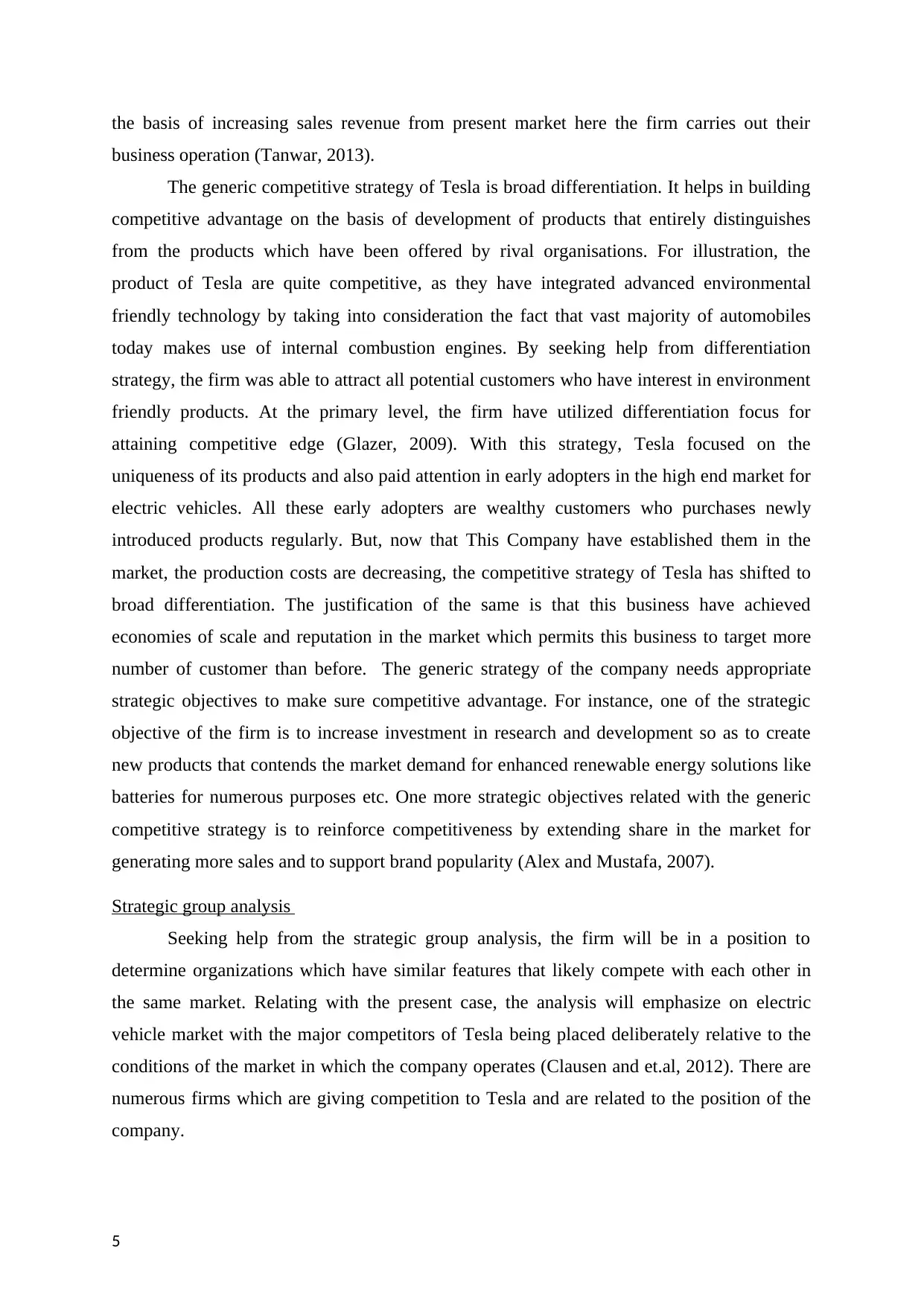
the basis of increasing sales revenue from present market here the firm carries out their
business operation (Tanwar, 2013).
The generic competitive strategy of Tesla is broad differentiation. It helps in building
competitive advantage on the basis of development of products that entirely distinguishes
from the products which have been offered by rival organisations. For illustration, the
product of Tesla are quite competitive, as they have integrated advanced environmental
friendly technology by taking into consideration the fact that vast majority of automobiles
today makes use of internal combustion engines. By seeking help from differentiation
strategy, the firm was able to attract all potential customers who have interest in environment
friendly products. At the primary level, the firm have utilized differentiation focus for
attaining competitive edge (Glazer, 2009). With this strategy, Tesla focused on the
uniqueness of its products and also paid attention in early adopters in the high end market for
electric vehicles. All these early adopters are wealthy customers who purchases newly
introduced products regularly. But, now that This Company have established them in the
market, the production costs are decreasing, the competitive strategy of Tesla has shifted to
broad differentiation. The justification of the same is that this business have achieved
economies of scale and reputation in the market which permits this business to target more
number of customer than before. The generic strategy of the company needs appropriate
strategic objectives to make sure competitive advantage. For instance, one of the strategic
objective of the firm is to increase investment in research and development so as to create
new products that contends the market demand for enhanced renewable energy solutions like
batteries for numerous purposes etc. One more strategic objectives related with the generic
competitive strategy is to reinforce competitiveness by extending share in the market for
generating more sales and to support brand popularity (Alex and Mustafa, 2007).
Strategic group analysis
Seeking help from the strategic group analysis, the firm will be in a position to
determine organizations which have similar features that likely compete with each other in
the same market. Relating with the present case, the analysis will emphasize on electric
vehicle market with the major competitors of Tesla being placed deliberately relative to the
conditions of the market in which the company operates (Clausen and et.al, 2012). There are
numerous firms which are giving competition to Tesla and are related to the position of the
company.
5
business operation (Tanwar, 2013).
The generic competitive strategy of Tesla is broad differentiation. It helps in building
competitive advantage on the basis of development of products that entirely distinguishes
from the products which have been offered by rival organisations. For illustration, the
product of Tesla are quite competitive, as they have integrated advanced environmental
friendly technology by taking into consideration the fact that vast majority of automobiles
today makes use of internal combustion engines. By seeking help from differentiation
strategy, the firm was able to attract all potential customers who have interest in environment
friendly products. At the primary level, the firm have utilized differentiation focus for
attaining competitive edge (Glazer, 2009). With this strategy, Tesla focused on the
uniqueness of its products and also paid attention in early adopters in the high end market for
electric vehicles. All these early adopters are wealthy customers who purchases newly
introduced products regularly. But, now that This Company have established them in the
market, the production costs are decreasing, the competitive strategy of Tesla has shifted to
broad differentiation. The justification of the same is that this business have achieved
economies of scale and reputation in the market which permits this business to target more
number of customer than before. The generic strategy of the company needs appropriate
strategic objectives to make sure competitive advantage. For instance, one of the strategic
objective of the firm is to increase investment in research and development so as to create
new products that contends the market demand for enhanced renewable energy solutions like
batteries for numerous purposes etc. One more strategic objectives related with the generic
competitive strategy is to reinforce competitiveness by extending share in the market for
generating more sales and to support brand popularity (Alex and Mustafa, 2007).
Strategic group analysis
Seeking help from the strategic group analysis, the firm will be in a position to
determine organizations which have similar features that likely compete with each other in
the same market. Relating with the present case, the analysis will emphasize on electric
vehicle market with the major competitors of Tesla being placed deliberately relative to the
conditions of the market in which the company operates (Clausen and et.al, 2012). There are
numerous firms which are giving competition to Tesla and are related to the position of the
company.
5
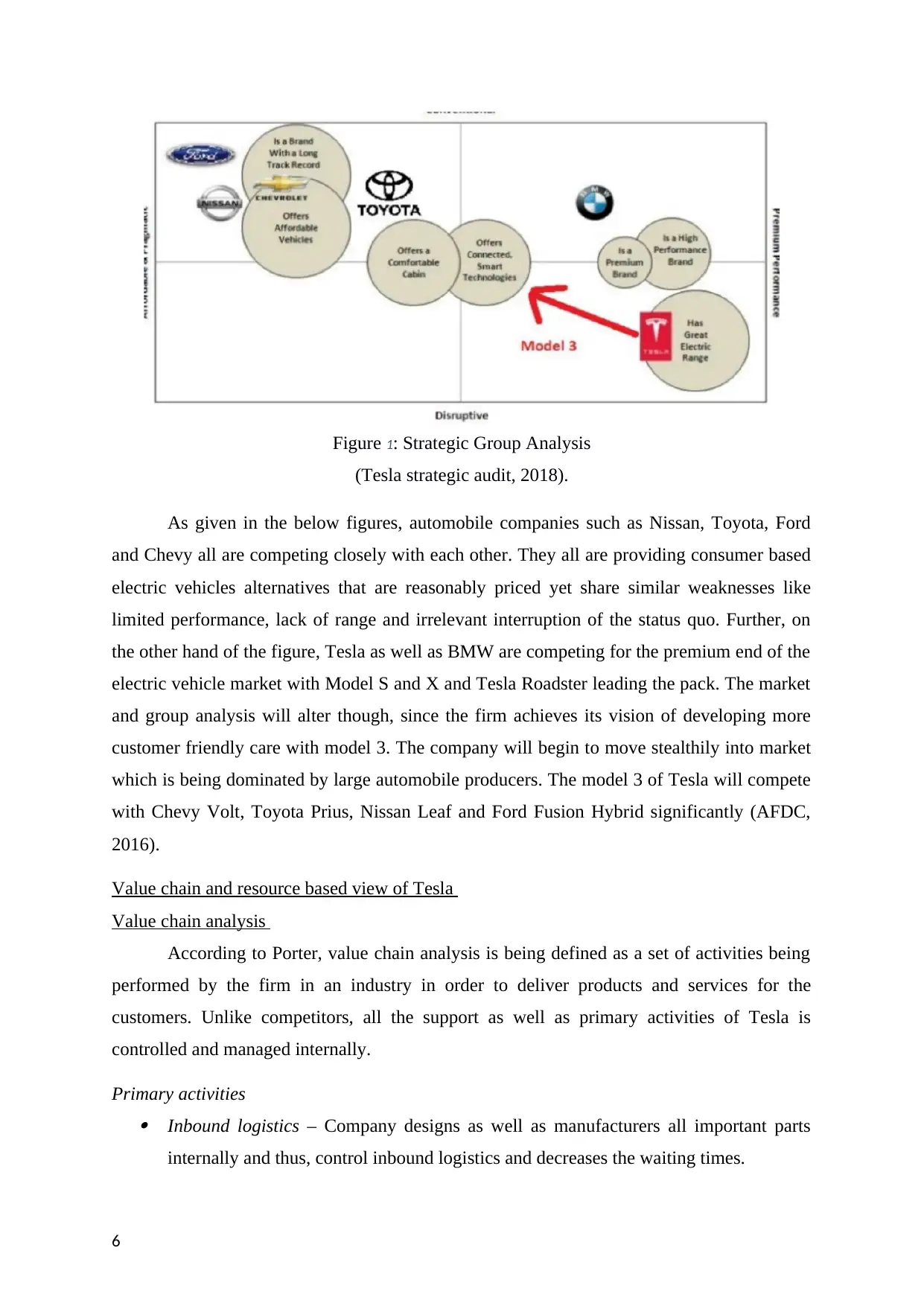
Figure 1: Strategic Group Analysis
(Tesla strategic audit, 2018).
As given in the below figures, automobile companies such as Nissan, Toyota, Ford
and Chevy all are competing closely with each other. They all are providing consumer based
electric vehicles alternatives that are reasonably priced yet share similar weaknesses like
limited performance, lack of range and irrelevant interruption of the status quo. Further, on
the other hand of the figure, Tesla as well as BMW are competing for the premium end of the
electric vehicle market with Model S and X and Tesla Roadster leading the pack. The market
and group analysis will alter though, since the firm achieves its vision of developing more
customer friendly care with model 3. The company will begin to move stealthily into market
which is being dominated by large automobile producers. The model 3 of Tesla will compete
with Chevy Volt, Toyota Prius, Nissan Leaf and Ford Fusion Hybrid significantly (AFDC,
2016).
Value chain and resource based view of Tesla
Value chain analysis
According to Porter, value chain analysis is being defined as a set of activities being
performed by the firm in an industry in order to deliver products and services for the
customers. Unlike competitors, all the support as well as primary activities of Tesla is
controlled and managed internally.
Primary activities Inbound logistics – Company designs as well as manufacturers all important parts
internally and thus, control inbound logistics and decreases the waiting times.
6
(Tesla strategic audit, 2018).
As given in the below figures, automobile companies such as Nissan, Toyota, Ford
and Chevy all are competing closely with each other. They all are providing consumer based
electric vehicles alternatives that are reasonably priced yet share similar weaknesses like
limited performance, lack of range and irrelevant interruption of the status quo. Further, on
the other hand of the figure, Tesla as well as BMW are competing for the premium end of the
electric vehicle market with Model S and X and Tesla Roadster leading the pack. The market
and group analysis will alter though, since the firm achieves its vision of developing more
customer friendly care with model 3. The company will begin to move stealthily into market
which is being dominated by large automobile producers. The model 3 of Tesla will compete
with Chevy Volt, Toyota Prius, Nissan Leaf and Ford Fusion Hybrid significantly (AFDC,
2016).
Value chain and resource based view of Tesla
Value chain analysis
According to Porter, value chain analysis is being defined as a set of activities being
performed by the firm in an industry in order to deliver products and services for the
customers. Unlike competitors, all the support as well as primary activities of Tesla is
controlled and managed internally.
Primary activities Inbound logistics – Company designs as well as manufacturers all important parts
internally and thus, control inbound logistics and decreases the waiting times.
6
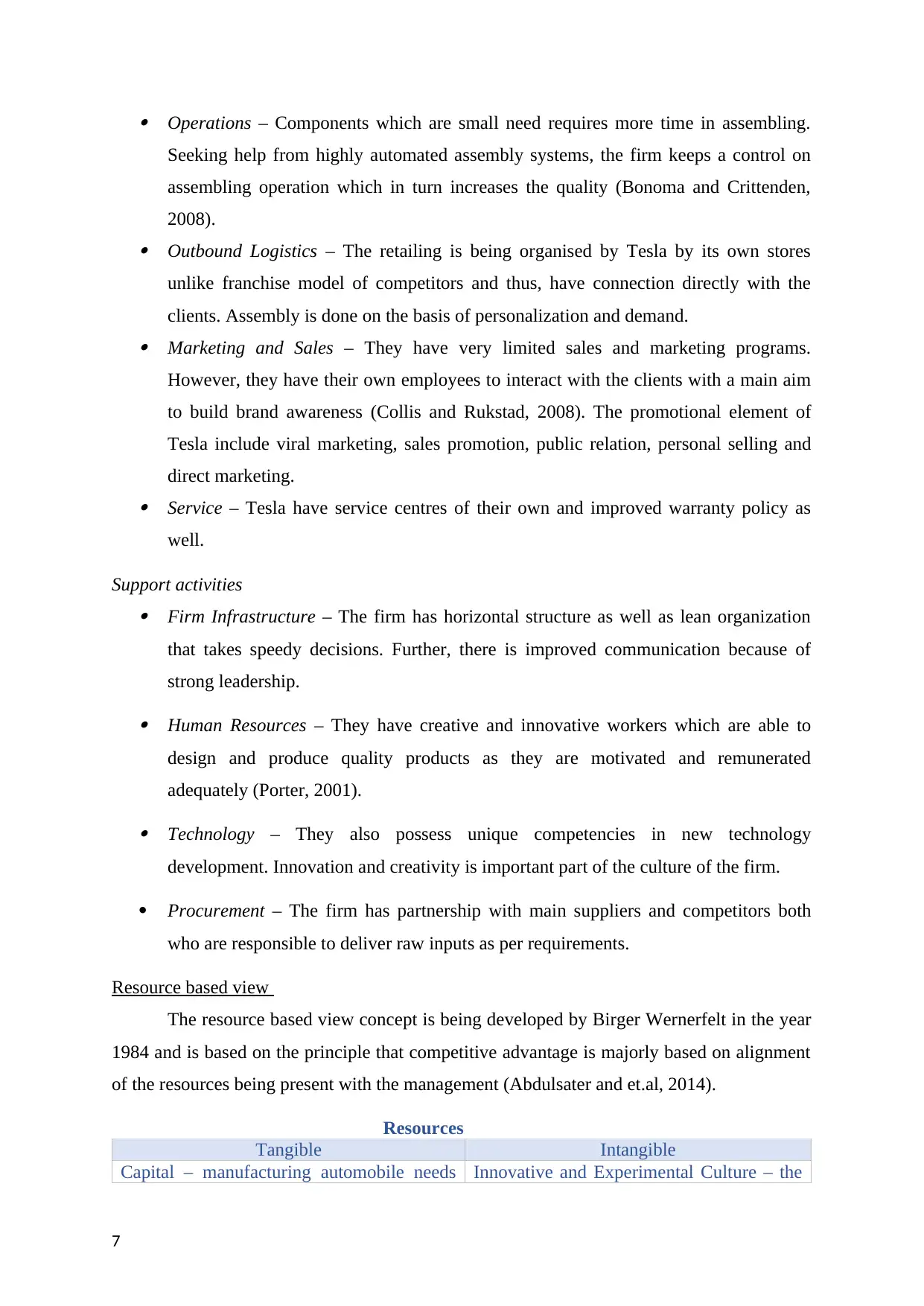
Operations – Components which are small need requires more time in assembling.
Seeking help from highly automated assembly systems, the firm keeps a control on
assembling operation which in turn increases the quality (Bonoma and Crittenden,
2008). Outbound Logistics – The retailing is being organised by Tesla by its own stores
unlike franchise model of competitors and thus, have connection directly with the
clients. Assembly is done on the basis of personalization and demand. Marketing and Sales – They have very limited sales and marketing programs.
However, they have their own employees to interact with the clients with a main aim
to build brand awareness (Collis and Rukstad, 2008). The promotional element of
Tesla include viral marketing, sales promotion, public relation, personal selling and
direct marketing. Service – Tesla have service centres of their own and improved warranty policy as
well.
Support activities Firm Infrastructure – The firm has horizontal structure as well as lean organization
that takes speedy decisions. Further, there is improved communication because of
strong leadership. Human Resources – They have creative and innovative workers which are able to
design and produce quality products as they are motivated and remunerated
adequately (Porter, 2001). Technology – They also possess unique competencies in new technology
development. Innovation and creativity is important part of the culture of the firm.
Procurement – The firm has partnership with main suppliers and competitors both
who are responsible to deliver raw inputs as per requirements.
Resource based view
The resource based view concept is being developed by Birger Wernerfelt in the year
1984 and is based on the principle that competitive advantage is majorly based on alignment
of the resources being present with the management (Abdulsater and et.al, 2014).
Resources
Tangible Intangible
Capital – manufacturing automobile needs Innovative and Experimental Culture – the
7
Seeking help from highly automated assembly systems, the firm keeps a control on
assembling operation which in turn increases the quality (Bonoma and Crittenden,
2008). Outbound Logistics – The retailing is being organised by Tesla by its own stores
unlike franchise model of competitors and thus, have connection directly with the
clients. Assembly is done on the basis of personalization and demand. Marketing and Sales – They have very limited sales and marketing programs.
However, they have their own employees to interact with the clients with a main aim
to build brand awareness (Collis and Rukstad, 2008). The promotional element of
Tesla include viral marketing, sales promotion, public relation, personal selling and
direct marketing. Service – Tesla have service centres of their own and improved warranty policy as
well.
Support activities Firm Infrastructure – The firm has horizontal structure as well as lean organization
that takes speedy decisions. Further, there is improved communication because of
strong leadership. Human Resources – They have creative and innovative workers which are able to
design and produce quality products as they are motivated and remunerated
adequately (Porter, 2001). Technology – They also possess unique competencies in new technology
development. Innovation and creativity is important part of the culture of the firm.
Procurement – The firm has partnership with main suppliers and competitors both
who are responsible to deliver raw inputs as per requirements.
Resource based view
The resource based view concept is being developed by Birger Wernerfelt in the year
1984 and is based on the principle that competitive advantage is majorly based on alignment
of the resources being present with the management (Abdulsater and et.al, 2014).
Resources
Tangible Intangible
Capital – manufacturing automobile needs Innovative and Experimental Culture – the
7
Paraphrase This Document
Need a fresh take? Get an instant paraphrase of this document with our AI Paraphraser
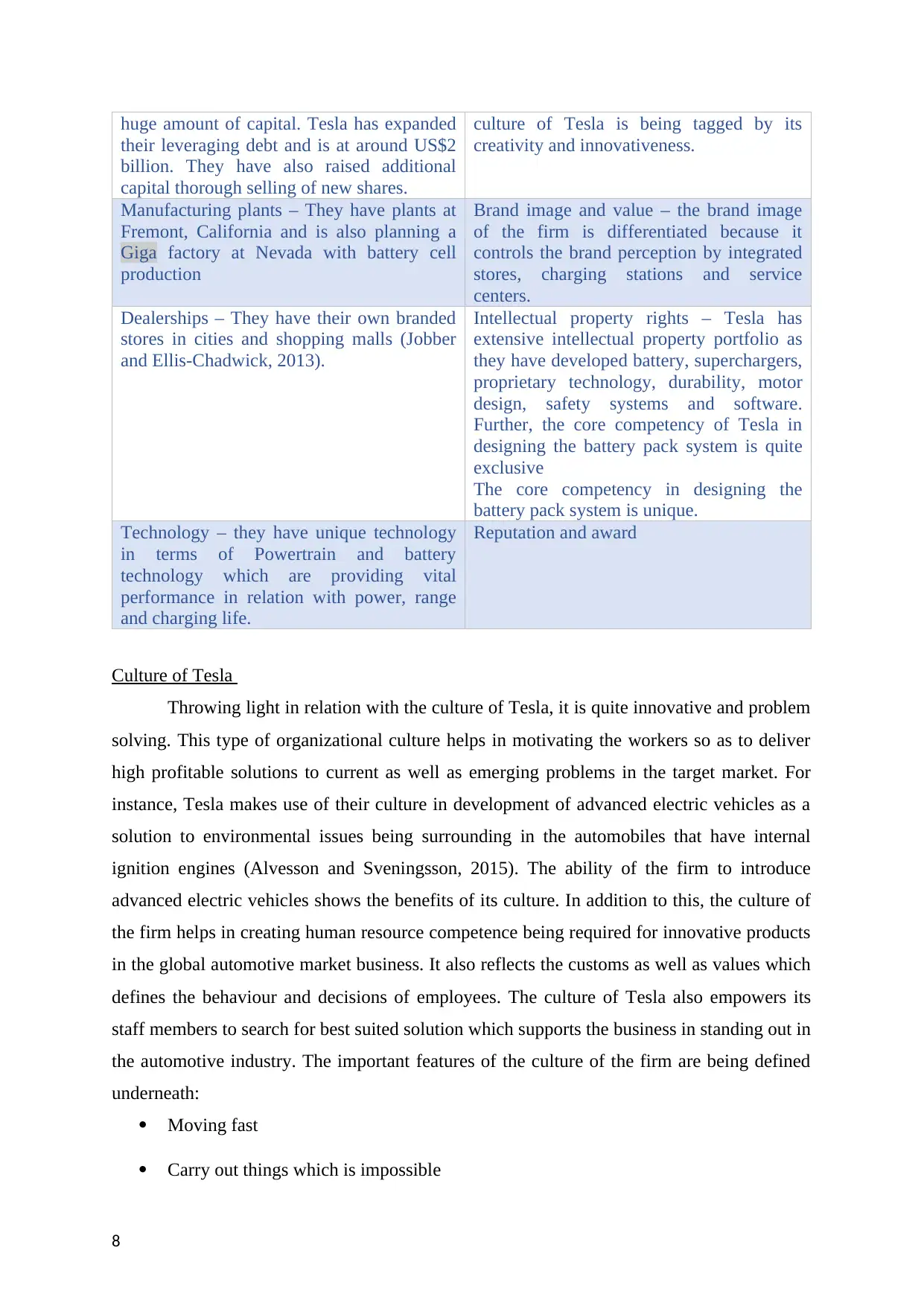
huge amount of capital. Tesla has expanded
their leveraging debt and is at around US$2
billion. They have also raised additional
capital thorough selling of new shares.
culture of Tesla is being tagged by its
creativity and innovativeness.
Manufacturing plants – They have plants at
Fremont, California and is also planning a
Giga factory at Nevada with battery cell
production
Brand image and value – the brand image
of the firm is differentiated because it
controls the brand perception by integrated
stores, charging stations and service
centers.
Dealerships – They have their own branded
stores in cities and shopping malls (Jobber
and Ellis-Chadwick, 2013).
Intellectual property rights – Tesla has
extensive intellectual property portfolio as
they have developed battery, superchargers,
proprietary technology, durability, motor
design, safety systems and software.
Further, the core competency of Tesla in
designing the battery pack system is quite
exclusive
The core competency in designing the
battery pack system is unique.
Technology – they have unique technology
in terms of Powertrain and battery
technology which are providing vital
performance in relation with power, range
and charging life.
Reputation and award
Culture of Tesla
Throwing light in relation with the culture of Tesla, it is quite innovative and problem
solving. This type of organizational culture helps in motivating the workers so as to deliver
high profitable solutions to current as well as emerging problems in the target market. For
instance, Tesla makes use of their culture in development of advanced electric vehicles as a
solution to environmental issues being surrounding in the automobiles that have internal
ignition engines (Alvesson and Sveningsson, 2015). The ability of the firm to introduce
advanced electric vehicles shows the benefits of its culture. In addition to this, the culture of
the firm helps in creating human resource competence being required for innovative products
in the global automotive market business. It also reflects the customs as well as values which
defines the behaviour and decisions of employees. The culture of Tesla also empowers its
staff members to search for best suited solution which supports the business in standing out in
the automotive industry. The important features of the culture of the firm are being defined
underneath:
Moving fast
Carry out things which is impossible
8
their leveraging debt and is at around US$2
billion. They have also raised additional
capital thorough selling of new shares.
culture of Tesla is being tagged by its
creativity and innovativeness.
Manufacturing plants – They have plants at
Fremont, California and is also planning a
Giga factory at Nevada with battery cell
production
Brand image and value – the brand image
of the firm is differentiated because it
controls the brand perception by integrated
stores, charging stations and service
centers.
Dealerships – They have their own branded
stores in cities and shopping malls (Jobber
and Ellis-Chadwick, 2013).
Intellectual property rights – Tesla has
extensive intellectual property portfolio as
they have developed battery, superchargers,
proprietary technology, durability, motor
design, safety systems and software.
Further, the core competency of Tesla in
designing the battery pack system is quite
exclusive
The core competency in designing the
battery pack system is unique.
Technology – they have unique technology
in terms of Powertrain and battery
technology which are providing vital
performance in relation with power, range
and charging life.
Reputation and award
Culture of Tesla
Throwing light in relation with the culture of Tesla, it is quite innovative and problem
solving. This type of organizational culture helps in motivating the workers so as to deliver
high profitable solutions to current as well as emerging problems in the target market. For
instance, Tesla makes use of their culture in development of advanced electric vehicles as a
solution to environmental issues being surrounding in the automobiles that have internal
ignition engines (Alvesson and Sveningsson, 2015). The ability of the firm to introduce
advanced electric vehicles shows the benefits of its culture. In addition to this, the culture of
the firm helps in creating human resource competence being required for innovative products
in the global automotive market business. It also reflects the customs as well as values which
defines the behaviour and decisions of employees. The culture of Tesla also empowers its
staff members to search for best suited solution which supports the business in standing out in
the automotive industry. The important features of the culture of the firm are being defined
underneath:
Moving fast
Carry out things which is impossible
8
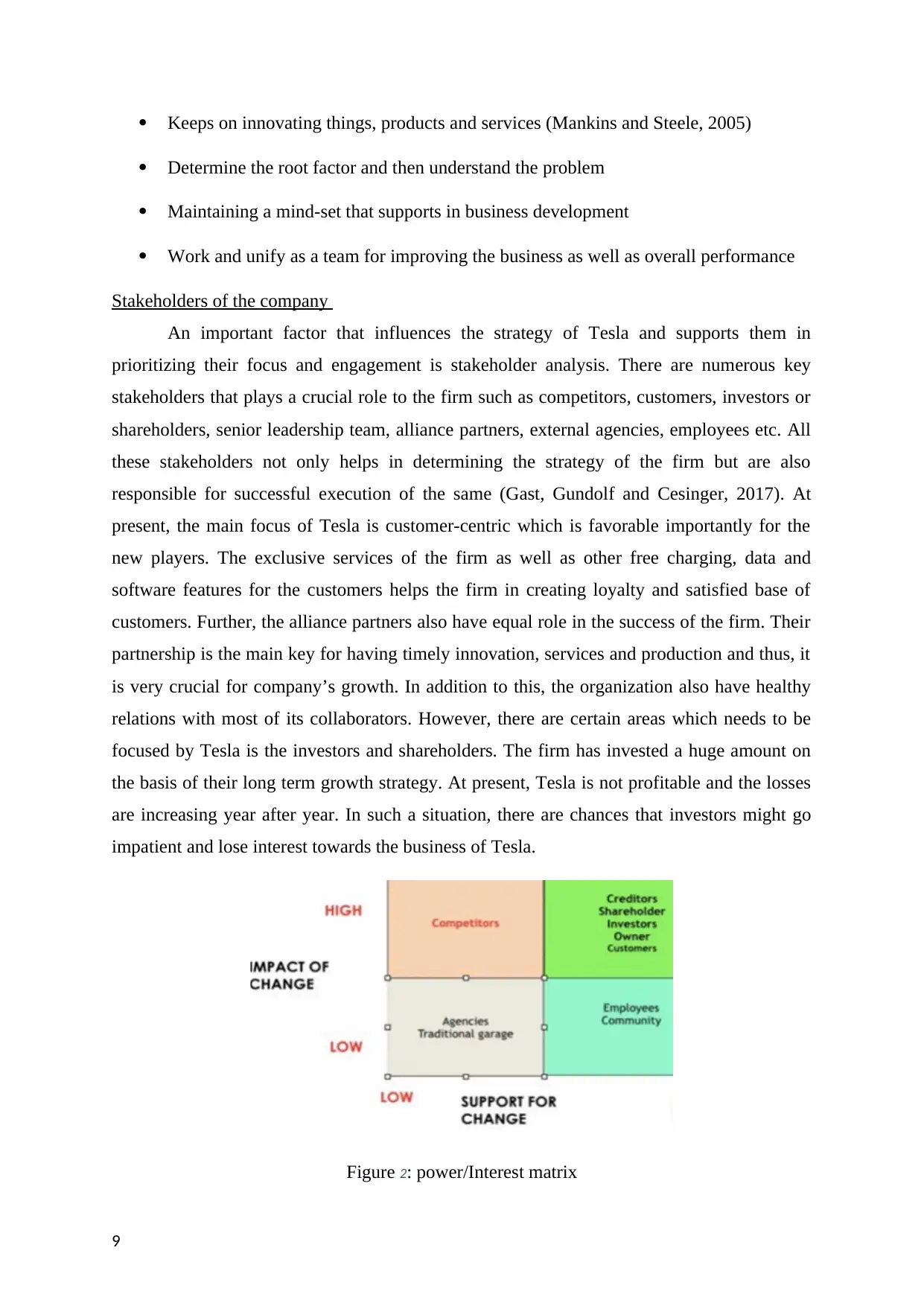
Keeps on innovating things, products and services (Mankins and Steele, 2005)
Determine the root factor and then understand the problem
Maintaining a mind-set that supports in business development
Work and unify as a team for improving the business as well as overall performance
Stakeholders of the company
An important factor that influences the strategy of Tesla and supports them in
prioritizing their focus and engagement is stakeholder analysis. There are numerous key
stakeholders that plays a crucial role to the firm such as competitors, customers, investors or
shareholders, senior leadership team, alliance partners, external agencies, employees etc. All
these stakeholders not only helps in determining the strategy of the firm but are also
responsible for successful execution of the same (Gast, Gundolf and Cesinger, 2017). At
present, the main focus of Tesla is customer-centric which is favorable importantly for the
new players. The exclusive services of the firm as well as other free charging, data and
software features for the customers helps the firm in creating loyalty and satisfied base of
customers. Further, the alliance partners also have equal role in the success of the firm. Their
partnership is the main key for having timely innovation, services and production and thus, it
is very crucial for company’s growth. In addition to this, the organization also have healthy
relations with most of its collaborators. However, there are certain areas which needs to be
focused by Tesla is the investors and shareholders. The firm has invested a huge amount on
the basis of their long term growth strategy. At present, Tesla is not profitable and the losses
are increasing year after year. In such a situation, there are chances that investors might go
impatient and lose interest towards the business of Tesla.
Figure 2: power/Interest matrix
9
Determine the root factor and then understand the problem
Maintaining a mind-set that supports in business development
Work and unify as a team for improving the business as well as overall performance
Stakeholders of the company
An important factor that influences the strategy of Tesla and supports them in
prioritizing their focus and engagement is stakeholder analysis. There are numerous key
stakeholders that plays a crucial role to the firm such as competitors, customers, investors or
shareholders, senior leadership team, alliance partners, external agencies, employees etc. All
these stakeholders not only helps in determining the strategy of the firm but are also
responsible for successful execution of the same (Gast, Gundolf and Cesinger, 2017). At
present, the main focus of Tesla is customer-centric which is favorable importantly for the
new players. The exclusive services of the firm as well as other free charging, data and
software features for the customers helps the firm in creating loyalty and satisfied base of
customers. Further, the alliance partners also have equal role in the success of the firm. Their
partnership is the main key for having timely innovation, services and production and thus, it
is very crucial for company’s growth. In addition to this, the organization also have healthy
relations with most of its collaborators. However, there are certain areas which needs to be
focused by Tesla is the investors and shareholders. The firm has invested a huge amount on
the basis of their long term growth strategy. At present, Tesla is not profitable and the losses
are increasing year after year. In such a situation, there are chances that investors might go
impatient and lose interest towards the business of Tesla.
Figure 2: power/Interest matrix
9
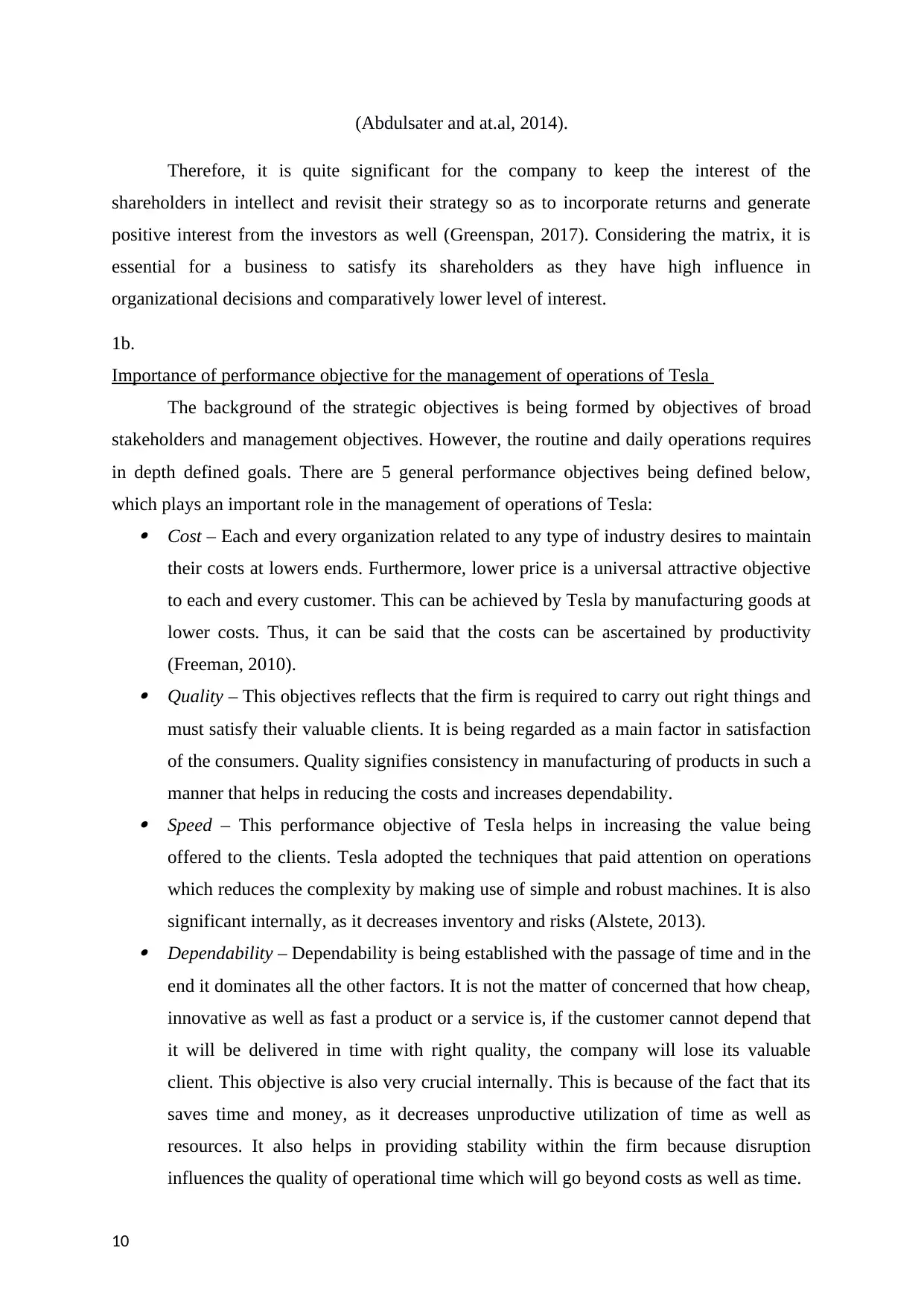
(Abdulsater and at.al, 2014).
Therefore, it is quite significant for the company to keep the interest of the
shareholders in intellect and revisit their strategy so as to incorporate returns and generate
positive interest from the investors as well (Greenspan, 2017). Considering the matrix, it is
essential for a business to satisfy its shareholders as they have high influence in
organizational decisions and comparatively lower level of interest.
1b.
Importance of performance objective for the management of operations of Tesla
The background of the strategic objectives is being formed by objectives of broad
stakeholders and management objectives. However, the routine and daily operations requires
in depth defined goals. There are 5 general performance objectives being defined below,
which plays an important role in the management of operations of Tesla: Cost – Each and every organization related to any type of industry desires to maintain
their costs at lowers ends. Furthermore, lower price is a universal attractive objective
to each and every customer. This can be achieved by Tesla by manufacturing goods at
lower costs. Thus, it can be said that the costs can be ascertained by productivity
(Freeman, 2010). Quality – This objectives reflects that the firm is required to carry out right things and
must satisfy their valuable clients. It is being regarded as a main factor in satisfaction
of the consumers. Quality signifies consistency in manufacturing of products in such a
manner that helps in reducing the costs and increases dependability. Speed – This performance objective of Tesla helps in increasing the value being
offered to the clients. Tesla adopted the techniques that paid attention on operations
which reduces the complexity by making use of simple and robust machines. It is also
significant internally, as it decreases inventory and risks (Alstete, 2013). Dependability – Dependability is being established with the passage of time and in the
end it dominates all the other factors. It is not the matter of concerned that how cheap,
innovative as well as fast a product or a service is, if the customer cannot depend that
it will be delivered in time with right quality, the company will lose its valuable
client. This objective is also very crucial internally. This is because of the fact that its
saves time and money, as it decreases unproductive utilization of time as well as
resources. It also helps in providing stability within the firm because disruption
influences the quality of operational time which will go beyond costs as well as time.
10
Therefore, it is quite significant for the company to keep the interest of the
shareholders in intellect and revisit their strategy so as to incorporate returns and generate
positive interest from the investors as well (Greenspan, 2017). Considering the matrix, it is
essential for a business to satisfy its shareholders as they have high influence in
organizational decisions and comparatively lower level of interest.
1b.
Importance of performance objective for the management of operations of Tesla
The background of the strategic objectives is being formed by objectives of broad
stakeholders and management objectives. However, the routine and daily operations requires
in depth defined goals. There are 5 general performance objectives being defined below,
which plays an important role in the management of operations of Tesla: Cost – Each and every organization related to any type of industry desires to maintain
their costs at lowers ends. Furthermore, lower price is a universal attractive objective
to each and every customer. This can be achieved by Tesla by manufacturing goods at
lower costs. Thus, it can be said that the costs can be ascertained by productivity
(Freeman, 2010). Quality – This objectives reflects that the firm is required to carry out right things and
must satisfy their valuable clients. It is being regarded as a main factor in satisfaction
of the consumers. Quality signifies consistency in manufacturing of products in such a
manner that helps in reducing the costs and increases dependability. Speed – This performance objective of Tesla helps in increasing the value being
offered to the clients. Tesla adopted the techniques that paid attention on operations
which reduces the complexity by making use of simple and robust machines. It is also
significant internally, as it decreases inventory and risks (Alstete, 2013). Dependability – Dependability is being established with the passage of time and in the
end it dominates all the other factors. It is not the matter of concerned that how cheap,
innovative as well as fast a product or a service is, if the customer cannot depend that
it will be delivered in time with right quality, the company will lose its valuable
client. This objective is also very crucial internally. This is because of the fact that its
saves time and money, as it decreases unproductive utilization of time as well as
resources. It also helps in providing stability within the firm because disruption
influences the quality of operational time which will go beyond costs as well as time.
10
Secure Best Marks with AI Grader
Need help grading? Try our AI Grader for instant feedback on your assignments.
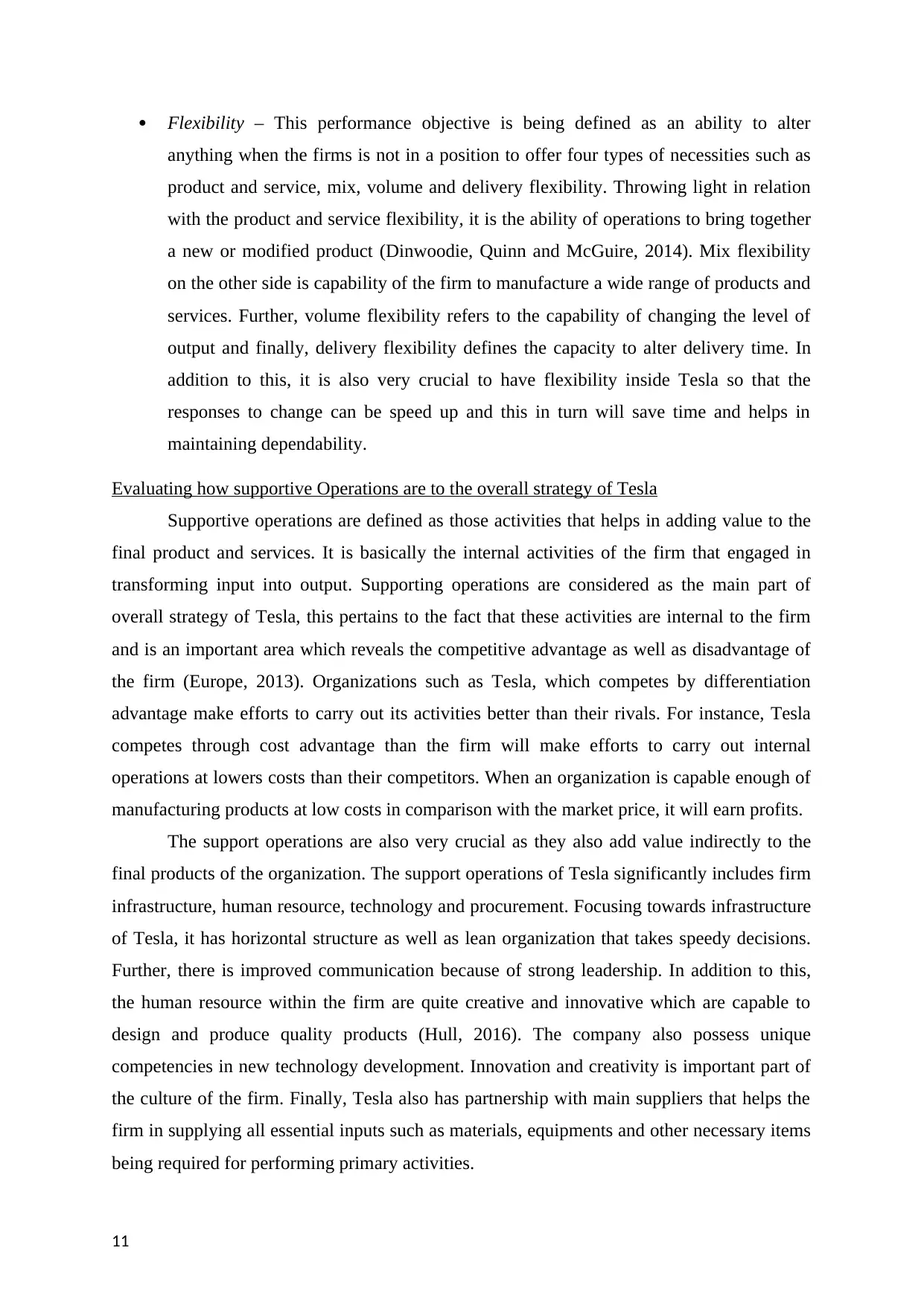
Flexibility – This performance objective is being defined as an ability to alter
anything when the firms is not in a position to offer four types of necessities such as
product and service, mix, volume and delivery flexibility. Throwing light in relation
with the product and service flexibility, it is the ability of operations to bring together
a new or modified product (Dinwoodie, Quinn and McGuire, 2014). Mix flexibility
on the other side is capability of the firm to manufacture a wide range of products and
services. Further, volume flexibility refers to the capability of changing the level of
output and finally, delivery flexibility defines the capacity to alter delivery time. In
addition to this, it is also very crucial to have flexibility inside Tesla so that the
responses to change can be speed up and this in turn will save time and helps in
maintaining dependability.
Evaluating how supportive Operations are to the overall strategy of Tesla
Supportive operations are defined as those activities that helps in adding value to the
final product and services. It is basically the internal activities of the firm that engaged in
transforming input into output. Supporting operations are considered as the main part of
overall strategy of Tesla, this pertains to the fact that these activities are internal to the firm
and is an important area which reveals the competitive advantage as well as disadvantage of
the firm (Europe, 2013). Organizations such as Tesla, which competes by differentiation
advantage make efforts to carry out its activities better than their rivals. For instance, Tesla
competes through cost advantage than the firm will make efforts to carry out internal
operations at lowers costs than their competitors. When an organization is capable enough of
manufacturing products at low costs in comparison with the market price, it will earn profits.
The support operations are also very crucial as they also add value indirectly to the
final products of the organization. The support operations of Tesla significantly includes firm
infrastructure, human resource, technology and procurement. Focusing towards infrastructure
of Tesla, it has horizontal structure as well as lean organization that takes speedy decisions.
Further, there is improved communication because of strong leadership. In addition to this,
the human resource within the firm are quite creative and innovative which are capable to
design and produce quality products (Hull, 2016). The company also possess unique
competencies in new technology development. Innovation and creativity is important part of
the culture of the firm. Finally, Tesla also has partnership with main suppliers that helps the
firm in supplying all essential inputs such as materials, equipments and other necessary items
being required for performing primary activities.
11
anything when the firms is not in a position to offer four types of necessities such as
product and service, mix, volume and delivery flexibility. Throwing light in relation
with the product and service flexibility, it is the ability of operations to bring together
a new or modified product (Dinwoodie, Quinn and McGuire, 2014). Mix flexibility
on the other side is capability of the firm to manufacture a wide range of products and
services. Further, volume flexibility refers to the capability of changing the level of
output and finally, delivery flexibility defines the capacity to alter delivery time. In
addition to this, it is also very crucial to have flexibility inside Tesla so that the
responses to change can be speed up and this in turn will save time and helps in
maintaining dependability.
Evaluating how supportive Operations are to the overall strategy of Tesla
Supportive operations are defined as those activities that helps in adding value to the
final product and services. It is basically the internal activities of the firm that engaged in
transforming input into output. Supporting operations are considered as the main part of
overall strategy of Tesla, this pertains to the fact that these activities are internal to the firm
and is an important area which reveals the competitive advantage as well as disadvantage of
the firm (Europe, 2013). Organizations such as Tesla, which competes by differentiation
advantage make efforts to carry out its activities better than their rivals. For instance, Tesla
competes through cost advantage than the firm will make efforts to carry out internal
operations at lowers costs than their competitors. When an organization is capable enough of
manufacturing products at low costs in comparison with the market price, it will earn profits.
The support operations are also very crucial as they also add value indirectly to the
final products of the organization. The support operations of Tesla significantly includes firm
infrastructure, human resource, technology and procurement. Focusing towards infrastructure
of Tesla, it has horizontal structure as well as lean organization that takes speedy decisions.
Further, there is improved communication because of strong leadership. In addition to this,
the human resource within the firm are quite creative and innovative which are capable to
design and produce quality products (Hull, 2016). The company also possess unique
competencies in new technology development. Innovation and creativity is important part of
the culture of the firm. Finally, Tesla also has partnership with main suppliers that helps the
firm in supplying all essential inputs such as materials, equipments and other necessary items
being required for performing primary activities.
11
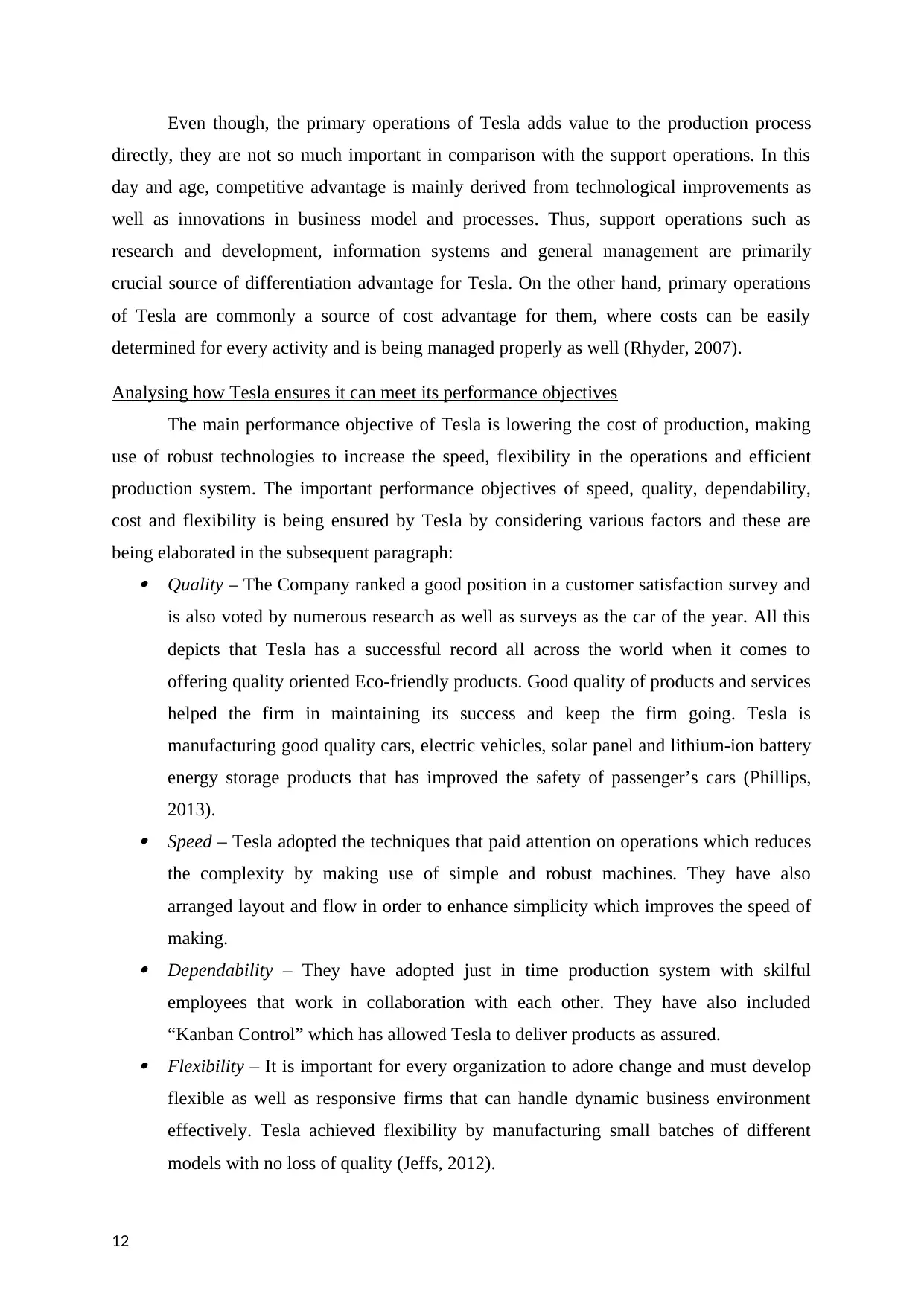
Even though, the primary operations of Tesla adds value to the production process
directly, they are not so much important in comparison with the support operations. In this
day and age, competitive advantage is mainly derived from technological improvements as
well as innovations in business model and processes. Thus, support operations such as
research and development, information systems and general management are primarily
crucial source of differentiation advantage for Tesla. On the other hand, primary operations
of Tesla are commonly a source of cost advantage for them, where costs can be easily
determined for every activity and is being managed properly as well (Rhyder, 2007).
Analysing how Tesla ensures it can meet its performance objectives
The main performance objective of Tesla is lowering the cost of production, making
use of robust technologies to increase the speed, flexibility in the operations and efficient
production system. The important performance objectives of speed, quality, dependability,
cost and flexibility is being ensured by Tesla by considering various factors and these are
being elaborated in the subsequent paragraph: Quality – The Company ranked a good position in a customer satisfaction survey and
is also voted by numerous research as well as surveys as the car of the year. All this
depicts that Tesla has a successful record all across the world when it comes to
offering quality oriented Eco-friendly products. Good quality of products and services
helped the firm in maintaining its success and keep the firm going. Tesla is
manufacturing good quality cars, electric vehicles, solar panel and lithium-ion battery
energy storage products that has improved the safety of passenger’s cars (Phillips,
2013). Speed – Tesla adopted the techniques that paid attention on operations which reduces
the complexity by making use of simple and robust machines. They have also
arranged layout and flow in order to enhance simplicity which improves the speed of
making. Dependability – They have adopted just in time production system with skilful
employees that work in collaboration with each other. They have also included
“Kanban Control” which has allowed Tesla to deliver products as assured. Flexibility – It is important for every organization to adore change and must develop
flexible as well as responsive firms that can handle dynamic business environment
effectively. Tesla achieved flexibility by manufacturing small batches of different
models with no loss of quality (Jeffs, 2012).
12
directly, they are not so much important in comparison with the support operations. In this
day and age, competitive advantage is mainly derived from technological improvements as
well as innovations in business model and processes. Thus, support operations such as
research and development, information systems and general management are primarily
crucial source of differentiation advantage for Tesla. On the other hand, primary operations
of Tesla are commonly a source of cost advantage for them, where costs can be easily
determined for every activity and is being managed properly as well (Rhyder, 2007).
Analysing how Tesla ensures it can meet its performance objectives
The main performance objective of Tesla is lowering the cost of production, making
use of robust technologies to increase the speed, flexibility in the operations and efficient
production system. The important performance objectives of speed, quality, dependability,
cost and flexibility is being ensured by Tesla by considering various factors and these are
being elaborated in the subsequent paragraph: Quality – The Company ranked a good position in a customer satisfaction survey and
is also voted by numerous research as well as surveys as the car of the year. All this
depicts that Tesla has a successful record all across the world when it comes to
offering quality oriented Eco-friendly products. Good quality of products and services
helped the firm in maintaining its success and keep the firm going. Tesla is
manufacturing good quality cars, electric vehicles, solar panel and lithium-ion battery
energy storage products that has improved the safety of passenger’s cars (Phillips,
2013). Speed – Tesla adopted the techniques that paid attention on operations which reduces
the complexity by making use of simple and robust machines. They have also
arranged layout and flow in order to enhance simplicity which improves the speed of
making. Dependability – They have adopted just in time production system with skilful
employees that work in collaboration with each other. They have also included
“Kanban Control” which has allowed Tesla to deliver products as assured. Flexibility – It is important for every organization to adore change and must develop
flexible as well as responsive firms that can handle dynamic business environment
effectively. Tesla achieved flexibility by manufacturing small batches of different
models with no loss of quality (Jeffs, 2012).
12
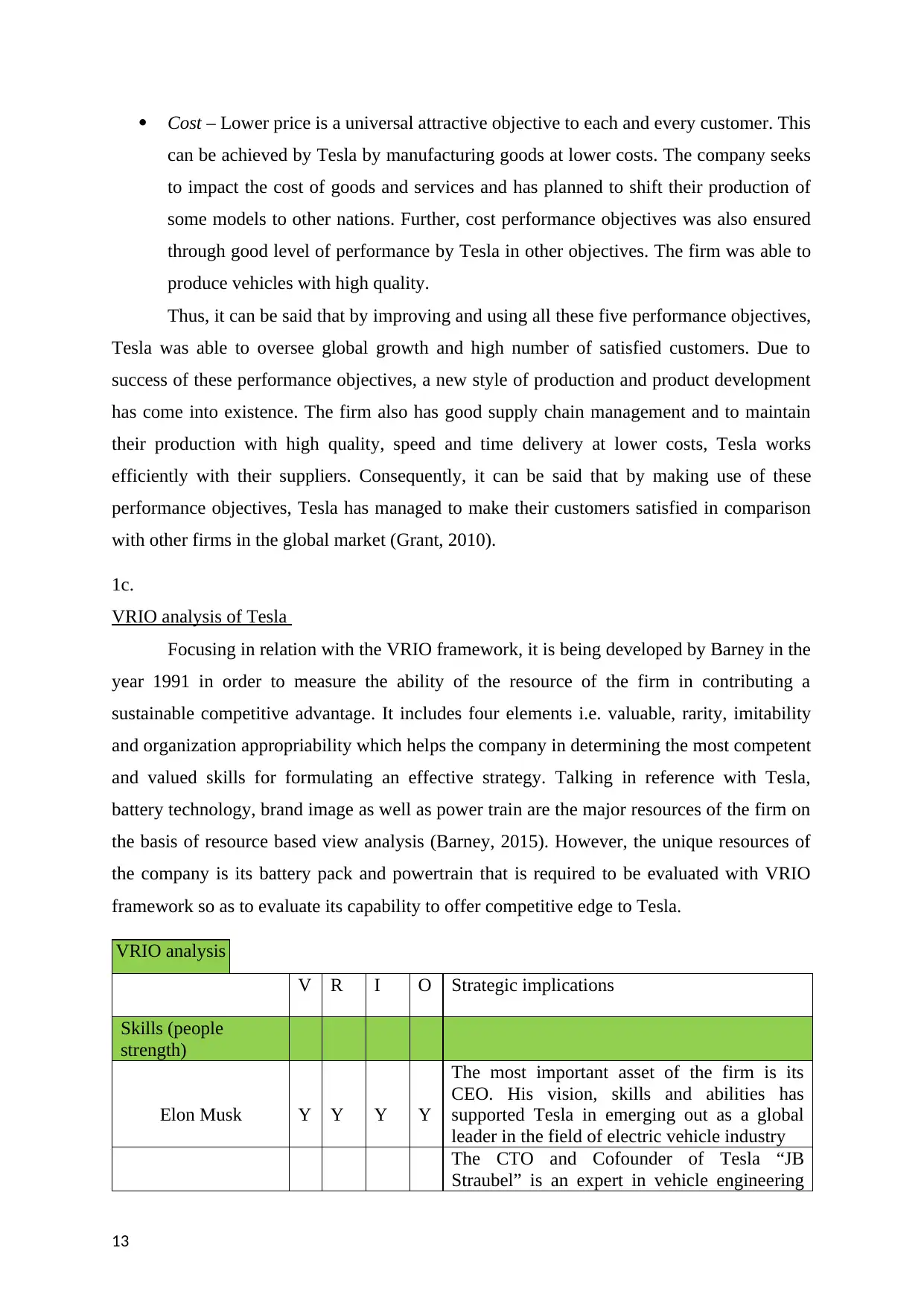
Cost – Lower price is a universal attractive objective to each and every customer. This
can be achieved by Tesla by manufacturing goods at lower costs. The company seeks
to impact the cost of goods and services and has planned to shift their production of
some models to other nations. Further, cost performance objectives was also ensured
through good level of performance by Tesla in other objectives. The firm was able to
produce vehicles with high quality.
Thus, it can be said that by improving and using all these five performance objectives,
Tesla was able to oversee global growth and high number of satisfied customers. Due to
success of these performance objectives, a new style of production and product development
has come into existence. The firm also has good supply chain management and to maintain
their production with high quality, speed and time delivery at lower costs, Tesla works
efficiently with their suppliers. Consequently, it can be said that by making use of these
performance objectives, Tesla has managed to make their customers satisfied in comparison
with other firms in the global market (Grant, 2010).
1c.
VRIO analysis of Tesla
Focusing in relation with the VRIO framework, it is being developed by Barney in the
year 1991 in order to measure the ability of the resource of the firm in contributing a
sustainable competitive advantage. It includes four elements i.e. valuable, rarity, imitability
and organization appropriability which helps the company in determining the most competent
and valued skills for formulating an effective strategy. Talking in reference with Tesla,
battery technology, brand image as well as power train are the major resources of the firm on
the basis of resource based view analysis (Barney, 2015). However, the unique resources of
the company is its battery pack and powertrain that is required to be evaluated with VRIO
framework so as to evaluate its capability to offer competitive edge to Tesla.
VRIO analysis
V R I O Strategic implications
Skills (people
strength)
Elon Musk Y Y Y Y
The most important asset of the firm is its
CEO. His vision, skills and abilities has
supported Tesla in emerging out as a global
leader in the field of electric vehicle industry
The CTO and Cofounder of Tesla “JB
Straubel” is an expert in vehicle engineering
13
can be achieved by Tesla by manufacturing goods at lower costs. The company seeks
to impact the cost of goods and services and has planned to shift their production of
some models to other nations. Further, cost performance objectives was also ensured
through good level of performance by Tesla in other objectives. The firm was able to
produce vehicles with high quality.
Thus, it can be said that by improving and using all these five performance objectives,
Tesla was able to oversee global growth and high number of satisfied customers. Due to
success of these performance objectives, a new style of production and product development
has come into existence. The firm also has good supply chain management and to maintain
their production with high quality, speed and time delivery at lower costs, Tesla works
efficiently with their suppliers. Consequently, it can be said that by making use of these
performance objectives, Tesla has managed to make their customers satisfied in comparison
with other firms in the global market (Grant, 2010).
1c.
VRIO analysis of Tesla
Focusing in relation with the VRIO framework, it is being developed by Barney in the
year 1991 in order to measure the ability of the resource of the firm in contributing a
sustainable competitive advantage. It includes four elements i.e. valuable, rarity, imitability
and organization appropriability which helps the company in determining the most competent
and valued skills for formulating an effective strategy. Talking in reference with Tesla,
battery technology, brand image as well as power train are the major resources of the firm on
the basis of resource based view analysis (Barney, 2015). However, the unique resources of
the company is its battery pack and powertrain that is required to be evaluated with VRIO
framework so as to evaluate its capability to offer competitive edge to Tesla.
VRIO analysis
V R I O Strategic implications
Skills (people
strength)
Elon Musk Y Y Y Y
The most important asset of the firm is its
CEO. His vision, skills and abilities has
supported Tesla in emerging out as a global
leader in the field of electric vehicle industry
The CTO and Cofounder of Tesla “JB
Straubel” is an expert in vehicle engineering
13
Paraphrase This Document
Need a fresh take? Get an instant paraphrase of this document with our AI Paraphraser
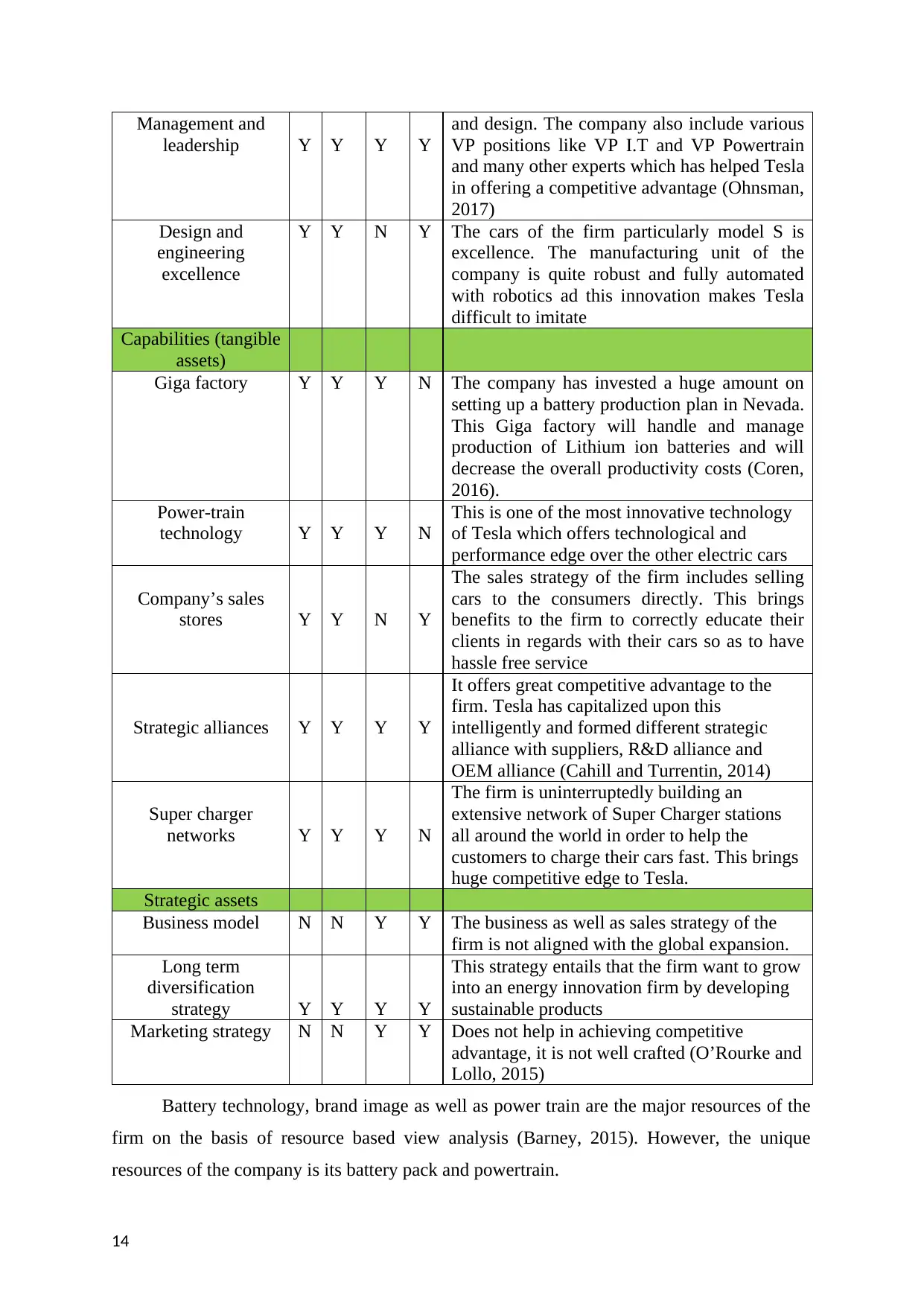
Management and
leadership Y Y Y Y
and design. The company also include various
VP positions like VP I.T and VP Powertrain
and many other experts which has helped Tesla
in offering a competitive advantage (Ohnsman,
2017)
Design and
engineering
excellence
Y Y N Y The cars of the firm particularly model S is
excellence. The manufacturing unit of the
company is quite robust and fully automated
with robotics ad this innovation makes Tesla
difficult to imitate
Capabilities (tangible
assets)
Giga factory Y Y Y N The company has invested a huge amount on
setting up a battery production plan in Nevada.
This Giga factory will handle and manage
production of Lithium ion batteries and will
decrease the overall productivity costs (Coren,
2016).
Power-train
technology Y Y Y N
This is one of the most innovative technology
of Tesla which offers technological and
performance edge over the other electric cars
Company’s sales
stores Y Y N Y
The sales strategy of the firm includes selling
cars to the consumers directly. This brings
benefits to the firm to correctly educate their
clients in regards with their cars so as to have
hassle free service
Strategic alliances Y Y Y Y
It offers great competitive advantage to the
firm. Tesla has capitalized upon this
intelligently and formed different strategic
alliance with suppliers, R&D alliance and
OEM alliance (Cahill and Turrentin, 2014)
Super charger
networks Y Y Y N
The firm is uninterruptedly building an
extensive network of Super Charger stations
all around the world in order to help the
customers to charge their cars fast. This brings
huge competitive edge to Tesla.
Strategic assets
Business model N N Y Y The business as well as sales strategy of the
firm is not aligned with the global expansion.
Long term
diversification
strategy Y Y Y Y
This strategy entails that the firm want to grow
into an energy innovation firm by developing
sustainable products
Marketing strategy N N Y Y Does not help in achieving competitive
advantage, it is not well crafted (O’Rourke and
Lollo, 2015)
Battery technology, brand image as well as power train are the major resources of the
firm on the basis of resource based view analysis (Barney, 2015). However, the unique
resources of the company is its battery pack and powertrain.
14
leadership Y Y Y Y
and design. The company also include various
VP positions like VP I.T and VP Powertrain
and many other experts which has helped Tesla
in offering a competitive advantage (Ohnsman,
2017)
Design and
engineering
excellence
Y Y N Y The cars of the firm particularly model S is
excellence. The manufacturing unit of the
company is quite robust and fully automated
with robotics ad this innovation makes Tesla
difficult to imitate
Capabilities (tangible
assets)
Giga factory Y Y Y N The company has invested a huge amount on
setting up a battery production plan in Nevada.
This Giga factory will handle and manage
production of Lithium ion batteries and will
decrease the overall productivity costs (Coren,
2016).
Power-train
technology Y Y Y N
This is one of the most innovative technology
of Tesla which offers technological and
performance edge over the other electric cars
Company’s sales
stores Y Y N Y
The sales strategy of the firm includes selling
cars to the consumers directly. This brings
benefits to the firm to correctly educate their
clients in regards with their cars so as to have
hassle free service
Strategic alliances Y Y Y Y
It offers great competitive advantage to the
firm. Tesla has capitalized upon this
intelligently and formed different strategic
alliance with suppliers, R&D alliance and
OEM alliance (Cahill and Turrentin, 2014)
Super charger
networks Y Y Y N
The firm is uninterruptedly building an
extensive network of Super Charger stations
all around the world in order to help the
customers to charge their cars fast. This brings
huge competitive edge to Tesla.
Strategic assets
Business model N N Y Y The business as well as sales strategy of the
firm is not aligned with the global expansion.
Long term
diversification
strategy Y Y Y Y
This strategy entails that the firm want to grow
into an energy innovation firm by developing
sustainable products
Marketing strategy N N Y Y Does not help in achieving competitive
advantage, it is not well crafted (O’Rourke and
Lollo, 2015)
Battery technology, brand image as well as power train are the major resources of the
firm on the basis of resource based view analysis (Barney, 2015). However, the unique
resources of the company is its battery pack and powertrain.
14
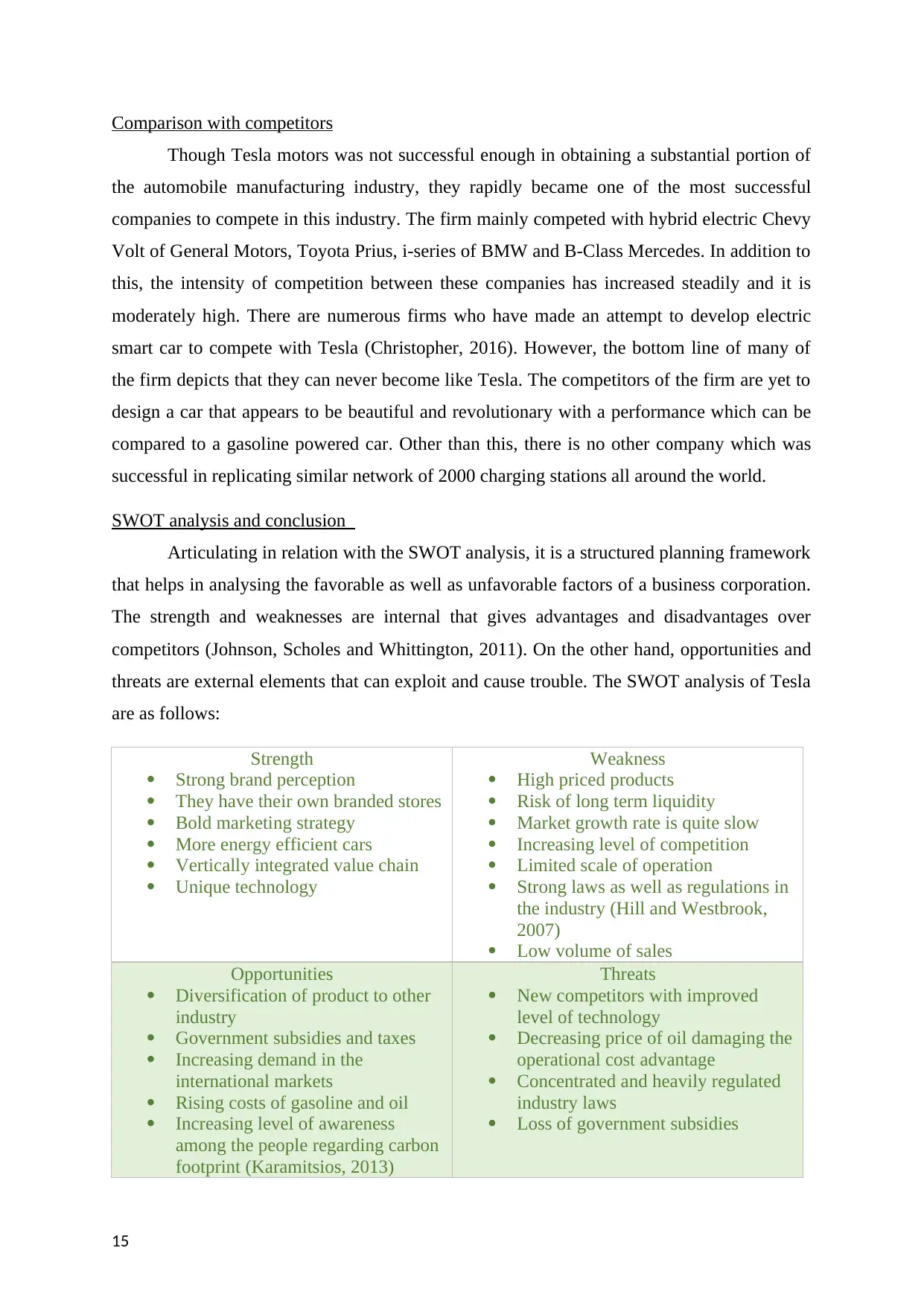
Comparison with competitors
Though Tesla motors was not successful enough in obtaining a substantial portion of
the automobile manufacturing industry, they rapidly became one of the most successful
companies to compete in this industry. The firm mainly competed with hybrid electric Chevy
Volt of General Motors, Toyota Prius, i-series of BMW and B-Class Mercedes. In addition to
this, the intensity of competition between these companies has increased steadily and it is
moderately high. There are numerous firms who have made an attempt to develop electric
smart car to compete with Tesla (Christopher, 2016). However, the bottom line of many of
the firm depicts that they can never become like Tesla. The competitors of the firm are yet to
design a car that appears to be beautiful and revolutionary with a performance which can be
compared to a gasoline powered car. Other than this, there is no other company which was
successful in replicating similar network of 2000 charging stations all around the world.
SWOT analysis and conclusion
Articulating in relation with the SWOT analysis, it is a structured planning framework
that helps in analysing the favorable as well as unfavorable factors of a business corporation.
The strength and weaknesses are internal that gives advantages and disadvantages over
competitors (Johnson, Scholes and Whittington, 2011). On the other hand, opportunities and
threats are external elements that can exploit and cause trouble. The SWOT analysis of Tesla
are as follows:
Strength
Strong brand perception
They have their own branded stores
Bold marketing strategy
More energy efficient cars
Vertically integrated value chain
Unique technology
Weakness
High priced products
Risk of long term liquidity
Market growth rate is quite slow
Increasing level of competition
Limited scale of operation
Strong laws as well as regulations in
the industry (Hill and Westbrook,
2007)
Low volume of sales
Opportunities
Diversification of product to other
industry
Government subsidies and taxes
Increasing demand in the
international markets
Rising costs of gasoline and oil
Increasing level of awareness
among the people regarding carbon
footprint (Karamitsios, 2013)
Threats
New competitors with improved
level of technology
Decreasing price of oil damaging the
operational cost advantage
Concentrated and heavily regulated
industry laws
Loss of government subsidies
15
Though Tesla motors was not successful enough in obtaining a substantial portion of
the automobile manufacturing industry, they rapidly became one of the most successful
companies to compete in this industry. The firm mainly competed with hybrid electric Chevy
Volt of General Motors, Toyota Prius, i-series of BMW and B-Class Mercedes. In addition to
this, the intensity of competition between these companies has increased steadily and it is
moderately high. There are numerous firms who have made an attempt to develop electric
smart car to compete with Tesla (Christopher, 2016). However, the bottom line of many of
the firm depicts that they can never become like Tesla. The competitors of the firm are yet to
design a car that appears to be beautiful and revolutionary with a performance which can be
compared to a gasoline powered car. Other than this, there is no other company which was
successful in replicating similar network of 2000 charging stations all around the world.
SWOT analysis and conclusion
Articulating in relation with the SWOT analysis, it is a structured planning framework
that helps in analysing the favorable as well as unfavorable factors of a business corporation.
The strength and weaknesses are internal that gives advantages and disadvantages over
competitors (Johnson, Scholes and Whittington, 2011). On the other hand, opportunities and
threats are external elements that can exploit and cause trouble. The SWOT analysis of Tesla
are as follows:
Strength
Strong brand perception
They have their own branded stores
Bold marketing strategy
More energy efficient cars
Vertically integrated value chain
Unique technology
Weakness
High priced products
Risk of long term liquidity
Market growth rate is quite slow
Increasing level of competition
Limited scale of operation
Strong laws as well as regulations in
the industry (Hill and Westbrook,
2007)
Low volume of sales
Opportunities
Diversification of product to other
industry
Government subsidies and taxes
Increasing demand in the
international markets
Rising costs of gasoline and oil
Increasing level of awareness
among the people regarding carbon
footprint (Karamitsios, 2013)
Threats
New competitors with improved
level of technology
Decreasing price of oil damaging the
operational cost advantage
Concentrated and heavily regulated
industry laws
Loss of government subsidies
15
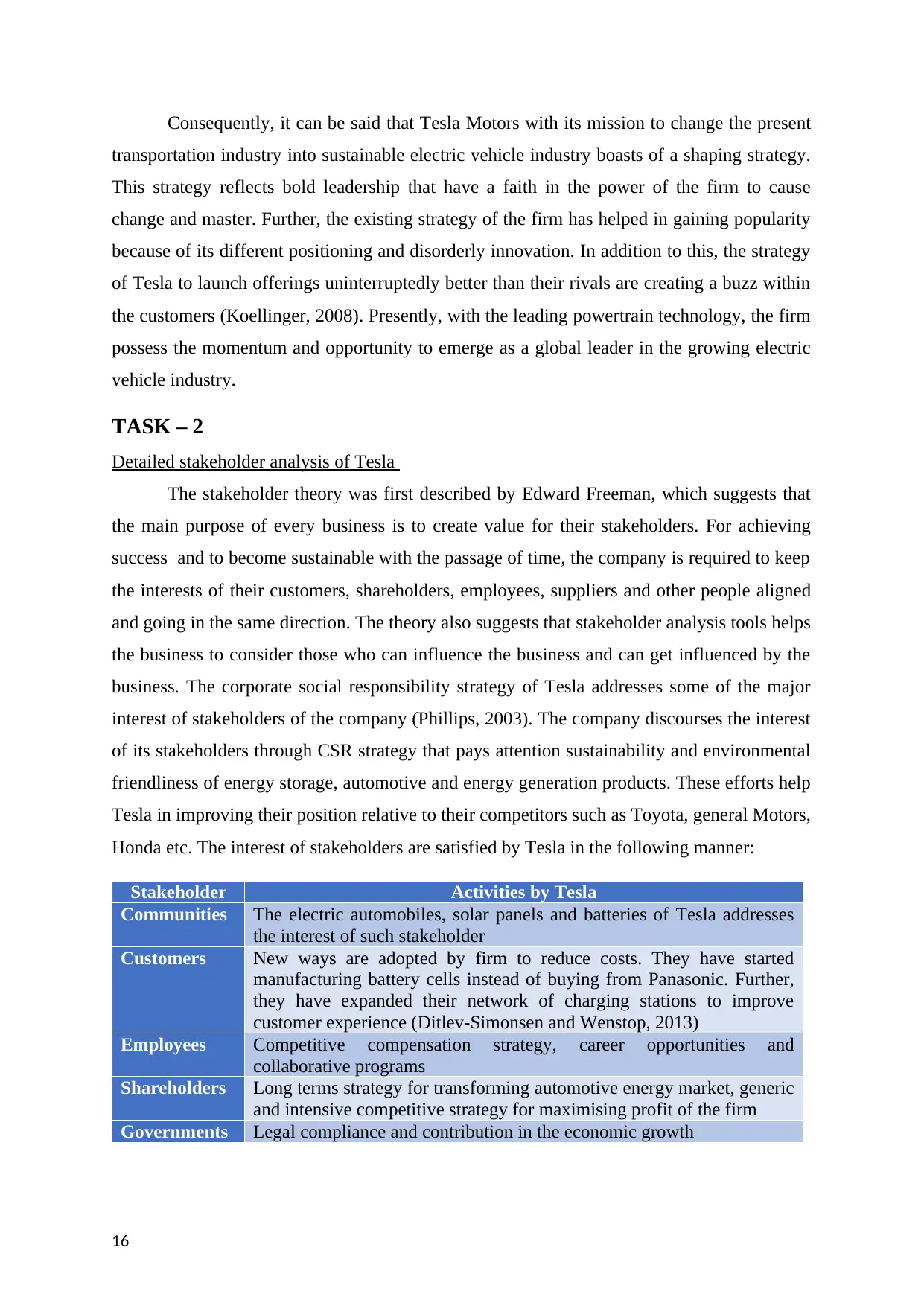
Consequently, it can be said that Tesla Motors with its mission to change the present
transportation industry into sustainable electric vehicle industry boasts of a shaping strategy.
This strategy reflects bold leadership that have a faith in the power of the firm to cause
change and master. Further, the existing strategy of the firm has helped in gaining popularity
because of its different positioning and disorderly innovation. In addition to this, the strategy
of Tesla to launch offerings uninterruptedly better than their rivals are creating a buzz within
the customers (Koellinger, 2008). Presently, with the leading powertrain technology, the firm
possess the momentum and opportunity to emerge as a global leader in the growing electric
vehicle industry.
TASK – 2
Detailed stakeholder analysis of Tesla
The stakeholder theory was first described by Edward Freeman, which suggests that
the main purpose of every business is to create value for their stakeholders. For achieving
success and to become sustainable with the passage of time, the company is required to keep
the interests of their customers, shareholders, employees, suppliers and other people aligned
and going in the same direction. The theory also suggests that stakeholder analysis tools helps
the business to consider those who can influence the business and can get influenced by the
business. The corporate social responsibility strategy of Tesla addresses some of the major
interest of stakeholders of the company (Phillips, 2003). The company discourses the interest
of its stakeholders through CSR strategy that pays attention sustainability and environmental
friendliness of energy storage, automotive and energy generation products. These efforts help
Tesla in improving their position relative to their competitors such as Toyota, general Motors,
Honda etc. The interest of stakeholders are satisfied by Tesla in the following manner:
Stakeholder Activities by Tesla
Communities The electric automobiles, solar panels and batteries of Tesla addresses
the interest of such stakeholder
Customers New ways are adopted by firm to reduce costs. They have started
manufacturing battery cells instead of buying from Panasonic. Further,
they have expanded their network of charging stations to improve
customer experience (Ditlev-Simonsen and Wenstop, 2013)
Employees Competitive compensation strategy, career opportunities and
collaborative programs
Shareholders Long terms strategy for transforming automotive energy market, generic
and intensive competitive strategy for maximising profit of the firm
Governments Legal compliance and contribution in the economic growth
16
transportation industry into sustainable electric vehicle industry boasts of a shaping strategy.
This strategy reflects bold leadership that have a faith in the power of the firm to cause
change and master. Further, the existing strategy of the firm has helped in gaining popularity
because of its different positioning and disorderly innovation. In addition to this, the strategy
of Tesla to launch offerings uninterruptedly better than their rivals are creating a buzz within
the customers (Koellinger, 2008). Presently, with the leading powertrain technology, the firm
possess the momentum and opportunity to emerge as a global leader in the growing electric
vehicle industry.
TASK – 2
Detailed stakeholder analysis of Tesla
The stakeholder theory was first described by Edward Freeman, which suggests that
the main purpose of every business is to create value for their stakeholders. For achieving
success and to become sustainable with the passage of time, the company is required to keep
the interests of their customers, shareholders, employees, suppliers and other people aligned
and going in the same direction. The theory also suggests that stakeholder analysis tools helps
the business to consider those who can influence the business and can get influenced by the
business. The corporate social responsibility strategy of Tesla addresses some of the major
interest of stakeholders of the company (Phillips, 2003). The company discourses the interest
of its stakeholders through CSR strategy that pays attention sustainability and environmental
friendliness of energy storage, automotive and energy generation products. These efforts help
Tesla in improving their position relative to their competitors such as Toyota, general Motors,
Honda etc. The interest of stakeholders are satisfied by Tesla in the following manner:
Stakeholder Activities by Tesla
Communities The electric automobiles, solar panels and batteries of Tesla addresses
the interest of such stakeholder
Customers New ways are adopted by firm to reduce costs. They have started
manufacturing battery cells instead of buying from Panasonic. Further,
they have expanded their network of charging stations to improve
customer experience (Ditlev-Simonsen and Wenstop, 2013)
Employees Competitive compensation strategy, career opportunities and
collaborative programs
Shareholders Long terms strategy for transforming automotive energy market, generic
and intensive competitive strategy for maximising profit of the firm
Governments Legal compliance and contribution in the economic growth
16
Secure Best Marks with AI Grader
Need help grading? Try our AI Grader for instant feedback on your assignments.

Out of all these stakeholders, investor or shareholders and community are the main
stakeholder or it can be said as the most powerful groups as than can pose threat to Tesla in
future. The strategy of the firm is satisfying the interest of all these stakeholders. But, the
firm needs to improve its programs in satisfying communities such as implementation of new
society development programs. In addition to this, Tesla can increase their efforts towards
international expansion in order to address the interest of shareholders in profiting from
automotive business (Crane and Matten, 2016). The expansion of business will add value to
the fulfilment of CSR of firms and will lesson down the threat of shareholder as well.
CONCLUSION
Thus, to conclude it can be said that despite gaining popularity from its innovative
technology and products, Tesla has attracted lot of critic from both media and industry.
Further, the firm is not yet profitable and is yet to prove its production competence. The
ambitious strategic goals of Tesla has invited competition significantly and has led the spark
in the electric motor vehicle industry.
17
stakeholder or it can be said as the most powerful groups as than can pose threat to Tesla in
future. The strategy of the firm is satisfying the interest of all these stakeholders. But, the
firm needs to improve its programs in satisfying communities such as implementation of new
society development programs. In addition to this, Tesla can increase their efforts towards
international expansion in order to address the interest of shareholders in profiting from
automotive business (Crane and Matten, 2016). The expansion of business will add value to
the fulfilment of CSR of firms and will lesson down the threat of shareholder as well.
CONCLUSION
Thus, to conclude it can be said that despite gaining popularity from its innovative
technology and products, Tesla has attracted lot of critic from both media and industry.
Further, the firm is not yet profitable and is yet to prove its production competence. The
ambitious strategic goals of Tesla has invited competition significantly and has led the spark
in the electric motor vehicle industry.
17
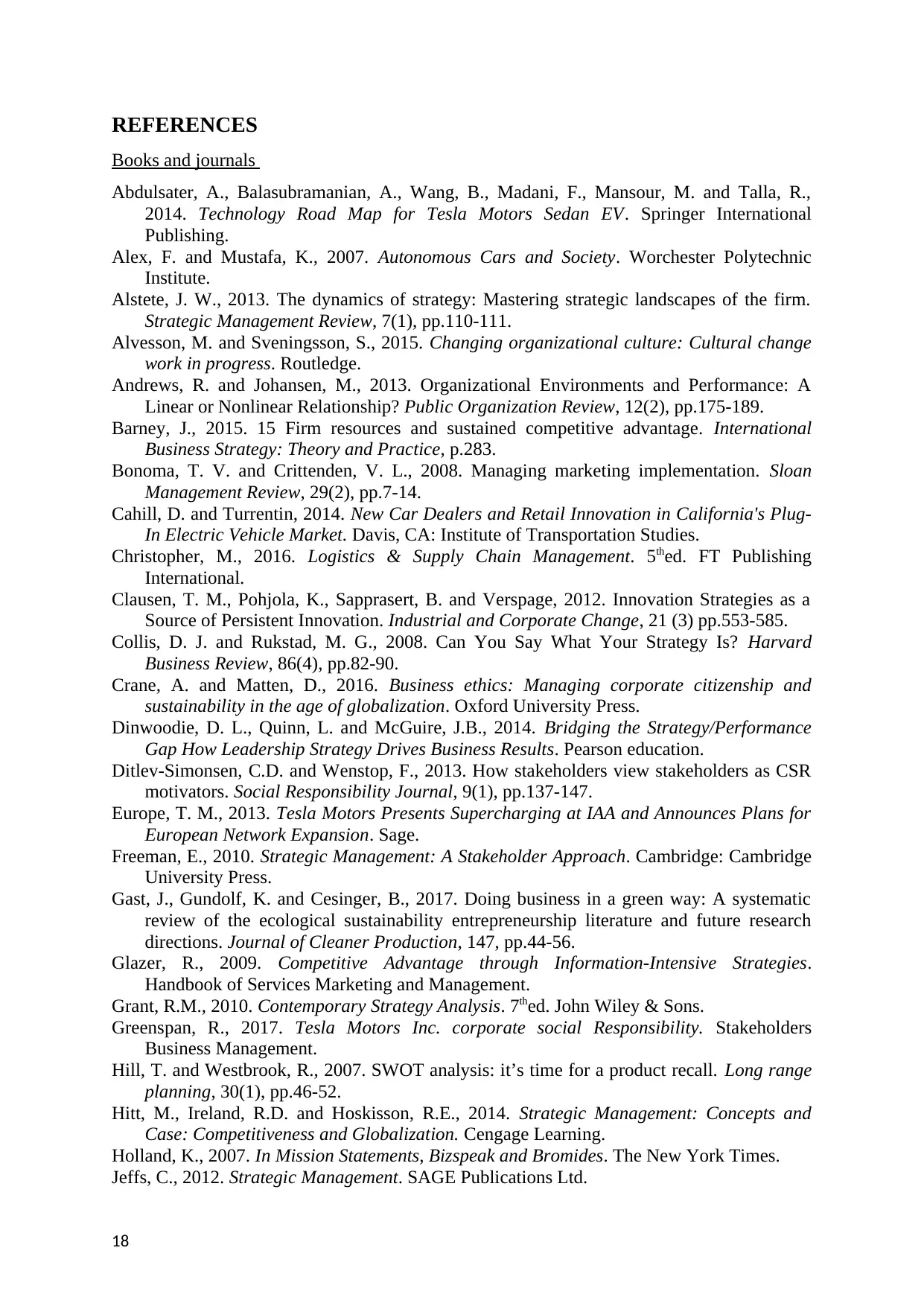
REFERENCES
Books and journals
Abdulsater, A., Balasubramanian, A., Wang, B., Madani, F., Mansour, M. and Talla, R.,
2014. Technology Road Map for Tesla Motors Sedan EV. Springer International
Publishing.
Alex, F. and Mustafa, K., 2007. Autonomous Cars and Society. Worchester Polytechnic
Institute.
Alstete, J. W., 2013. The dynamics of strategy: Mastering strategic landscapes of the firm.
Strategic Management Review, 7(1), pp.110-111.
Alvesson, M. and Sveningsson, S., 2015. Changing organizational culture: Cultural change
work in progress. Routledge.
Andrews, R. and Johansen, M., 2013. Organizational Environments and Performance: A
Linear or Nonlinear Relationship? Public Organization Review, 12(2), pp.175-189.
Barney, J., 2015. 15 Firm resources and sustained competitive advantage. International
Business Strategy: Theory and Practice, p.283.
Bonoma, T. V. and Crittenden, V. L., 2008. Managing marketing implementation. Sloan
Management Review, 29(2), pp.7-14.
Cahill, D. and Turrentin, 2014. New Car Dealers and Retail Innovation in California's Plug-
In Electric Vehicle Market. Davis, CA: Institute of Transportation Studies.
Christopher, M., 2016. Logistics & Supply Chain Management. 5thed. FT Publishing
International.
Clausen, T. M., Pohjola, K., Sapprasert, B. and Verspage, 2012. Innovation Strategies as a
Source of Persistent Innovation. Industrial and Corporate Change, 21 (3) pp.553-585.
Collis, D. J. and Rukstad, M. G., 2008. Can You Say What Your Strategy Is? Harvard
Business Review, 86(4), pp.82-90.
Crane, A. and Matten, D., 2016. Business ethics: Managing corporate citizenship and
sustainability in the age of globalization. Oxford University Press.
Dinwoodie, D. L., Quinn, L. and McGuire, J.B., 2014. Bridging the Strategy/Performance
Gap How Leadership Strategy Drives Business Results. Pearson education.
Ditlev-Simonsen, C.D. and Wenstop, F., 2013. How stakeholders view stakeholders as CSR
motivators. Social Responsibility Journal, 9(1), pp.137-147.
Europe, T. M., 2013. Tesla Motors Presents Supercharging at IAA and Announces Plans for
European Network Expansion. Sage.
Freeman, E., 2010. Strategic Management: A Stakeholder Approach. Cambridge: Cambridge
University Press.
Gast, J., Gundolf, K. and Cesinger, B., 2017. Doing business in a green way: A systematic
review of the ecological sustainability entrepreneurship literature and future research
directions. Journal of Cleaner Production, 147, pp.44-56.
Glazer, R., 2009. Competitive Advantage through Information-Intensive Strategies.
Handbook of Services Marketing and Management.
Grant, R.M., 2010. Contemporary Strategy Analysis. 7thed. John Wiley & Sons.
Greenspan, R., 2017. Tesla Motors Inc. corporate social Responsibility. Stakeholders
Business Management.
Hill, T. and Westbrook, R., 2007. SWOT analysis: it’s time for a product recall. Long range
planning, 30(1), pp.46-52.
Hitt, M., Ireland, R.D. and Hoskisson, R.E., 2014. Strategic Management: Concepts and
Case: Competitiveness and Globalization. Cengage Learning.
Holland, K., 2007. In Mission Statements, Bizspeak and Bromides. The New York Times.
Jeffs, C., 2012. Strategic Management. SAGE Publications Ltd.
18
Books and journals
Abdulsater, A., Balasubramanian, A., Wang, B., Madani, F., Mansour, M. and Talla, R.,
2014. Technology Road Map for Tesla Motors Sedan EV. Springer International
Publishing.
Alex, F. and Mustafa, K., 2007. Autonomous Cars and Society. Worchester Polytechnic
Institute.
Alstete, J. W., 2013. The dynamics of strategy: Mastering strategic landscapes of the firm.
Strategic Management Review, 7(1), pp.110-111.
Alvesson, M. and Sveningsson, S., 2015. Changing organizational culture: Cultural change
work in progress. Routledge.
Andrews, R. and Johansen, M., 2013. Organizational Environments and Performance: A
Linear or Nonlinear Relationship? Public Organization Review, 12(2), pp.175-189.
Barney, J., 2015. 15 Firm resources and sustained competitive advantage. International
Business Strategy: Theory and Practice, p.283.
Bonoma, T. V. and Crittenden, V. L., 2008. Managing marketing implementation. Sloan
Management Review, 29(2), pp.7-14.
Cahill, D. and Turrentin, 2014. New Car Dealers and Retail Innovation in California's Plug-
In Electric Vehicle Market. Davis, CA: Institute of Transportation Studies.
Christopher, M., 2016. Logistics & Supply Chain Management. 5thed. FT Publishing
International.
Clausen, T. M., Pohjola, K., Sapprasert, B. and Verspage, 2012. Innovation Strategies as a
Source of Persistent Innovation. Industrial and Corporate Change, 21 (3) pp.553-585.
Collis, D. J. and Rukstad, M. G., 2008. Can You Say What Your Strategy Is? Harvard
Business Review, 86(4), pp.82-90.
Crane, A. and Matten, D., 2016. Business ethics: Managing corporate citizenship and
sustainability in the age of globalization. Oxford University Press.
Dinwoodie, D. L., Quinn, L. and McGuire, J.B., 2014. Bridging the Strategy/Performance
Gap How Leadership Strategy Drives Business Results. Pearson education.
Ditlev-Simonsen, C.D. and Wenstop, F., 2013. How stakeholders view stakeholders as CSR
motivators. Social Responsibility Journal, 9(1), pp.137-147.
Europe, T. M., 2013. Tesla Motors Presents Supercharging at IAA and Announces Plans for
European Network Expansion. Sage.
Freeman, E., 2010. Strategic Management: A Stakeholder Approach. Cambridge: Cambridge
University Press.
Gast, J., Gundolf, K. and Cesinger, B., 2017. Doing business in a green way: A systematic
review of the ecological sustainability entrepreneurship literature and future research
directions. Journal of Cleaner Production, 147, pp.44-56.
Glazer, R., 2009. Competitive Advantage through Information-Intensive Strategies.
Handbook of Services Marketing and Management.
Grant, R.M., 2010. Contemporary Strategy Analysis. 7thed. John Wiley & Sons.
Greenspan, R., 2017. Tesla Motors Inc. corporate social Responsibility. Stakeholders
Business Management.
Hill, T. and Westbrook, R., 2007. SWOT analysis: it’s time for a product recall. Long range
planning, 30(1), pp.46-52.
Hitt, M., Ireland, R.D. and Hoskisson, R.E., 2014. Strategic Management: Concepts and
Case: Competitiveness and Globalization. Cengage Learning.
Holland, K., 2007. In Mission Statements, Bizspeak and Bromides. The New York Times.
Jeffs, C., 2012. Strategic Management. SAGE Publications Ltd.
18
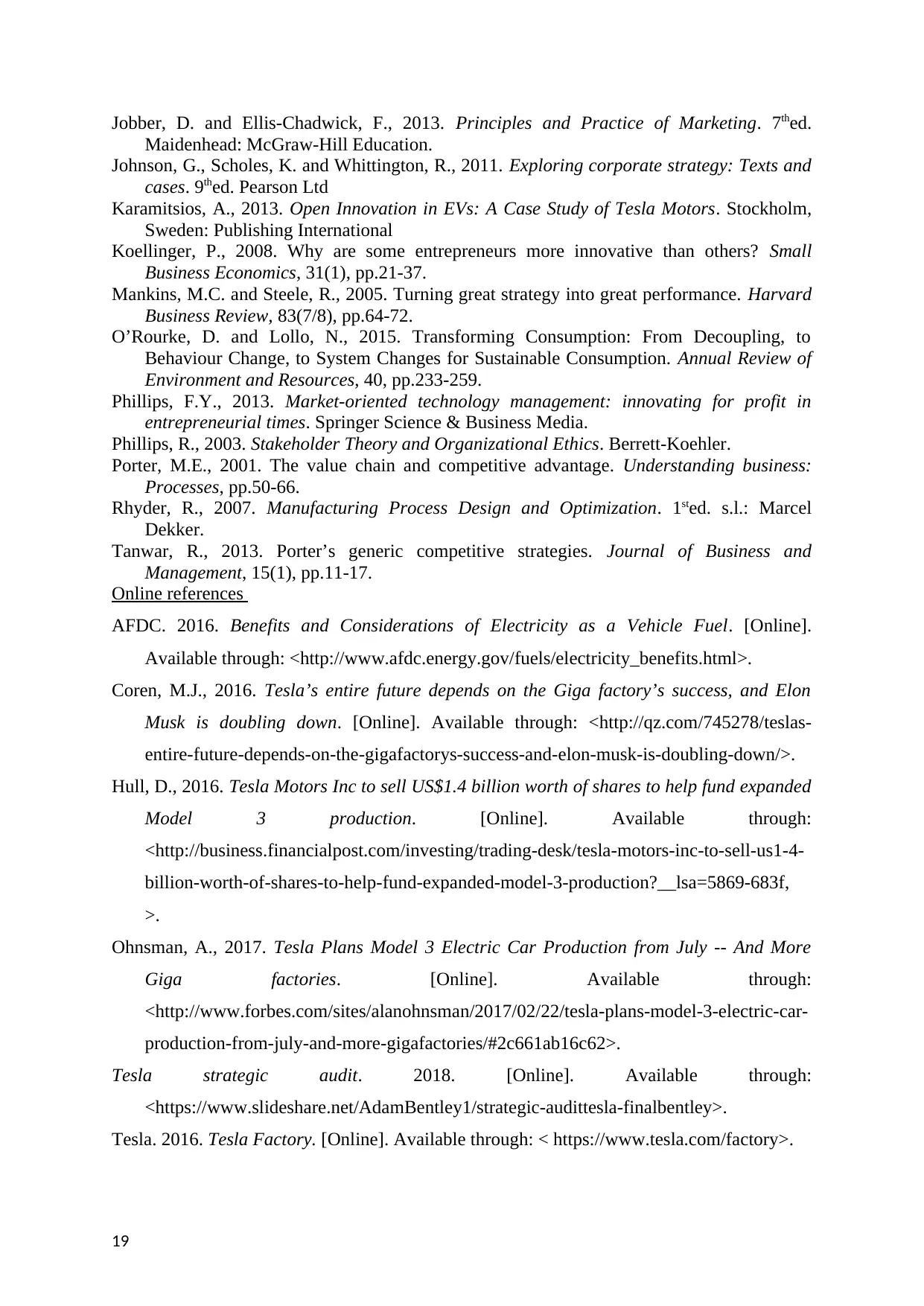
Jobber, D. and Ellis-Chadwick, F., 2013. Principles and Practice of Marketing. 7thed.
Maidenhead: McGraw-Hill Education.
Johnson, G., Scholes, K. and Whittington, R., 2011. Exploring corporate strategy: Texts and
cases. 9thed. Pearson Ltd
Karamitsios, A., 2013. Open Innovation in EVs: A Case Study of Tesla Motors. Stockholm,
Sweden: Publishing International
Koellinger, P., 2008. Why are some entrepreneurs more innovative than others? Small
Business Economics, 31(1), pp.21-37.
Mankins, M.C. and Steele, R., 2005. Turning great strategy into great performance. Harvard
Business Review, 83(7/8), pp.64-72.
O’Rourke, D. and Lollo, N., 2015. Transforming Consumption: From Decoupling, to
Behaviour Change, to System Changes for Sustainable Consumption. Annual Review of
Environment and Resources, 40, pp.233-259.
Phillips, F.Y., 2013. Market-oriented technology management: innovating for profit in
entrepreneurial times. Springer Science & Business Media.
Phillips, R., 2003. Stakeholder Theory and Organizational Ethics. Berrett-Koehler.
Porter, M.E., 2001. The value chain and competitive advantage. Understanding business:
Processes, pp.50-66.
Rhyder, R., 2007. Manufacturing Process Design and Optimization. 1sted. s.l.: Marcel
Dekker.
Tanwar, R., 2013. Porter’s generic competitive strategies. Journal of Business and
Management, 15(1), pp.11-17.
Online references
AFDC. 2016. Benefits and Considerations of Electricity as a Vehicle Fuel. [Online].
Available through: <http://www.afdc.energy.gov/fuels/electricity_benefits.html>.
Coren, M.J., 2016. Tesla’s entire future depends on the Giga factory’s success, and Elon
Musk is doubling down. [Online]. Available through: <http://qz.com/745278/teslas-
entire-future-depends-on-the-gigafactorys-success-and-elon-musk-is-doubling-down/>.
Hull, D., 2016. Tesla Motors Inc to sell US$1.4 billion worth of shares to help fund expanded
Model 3 production. [Online]. Available through:
<http://business.financialpost.com/investing/trading-desk/tesla-motors-inc-to-sell-us1-4-
billion-worth-of-shares-to-help-fund-expanded-model-3-production?__lsa=5869-683f,
>.
Ohnsman, A., 2017. Tesla Plans Model 3 Electric Car Production from July -- And More
Giga factories. [Online]. Available through:
<http://www.forbes.com/sites/alanohnsman/2017/02/22/tesla-plans-model-3-electric-car-
production-from-july-and-more-gigafactories/#2c661ab16c62>.
Tesla strategic audit. 2018. [Online]. Available through:
<https://www.slideshare.net/AdamBentley1/strategic-audittesla-finalbentley>.
Tesla. 2016. Tesla Factory. [Online]. Available through: < https://www.tesla.com/factory>.
19
Maidenhead: McGraw-Hill Education.
Johnson, G., Scholes, K. and Whittington, R., 2011. Exploring corporate strategy: Texts and
cases. 9thed. Pearson Ltd
Karamitsios, A., 2013. Open Innovation in EVs: A Case Study of Tesla Motors. Stockholm,
Sweden: Publishing International
Koellinger, P., 2008. Why are some entrepreneurs more innovative than others? Small
Business Economics, 31(1), pp.21-37.
Mankins, M.C. and Steele, R., 2005. Turning great strategy into great performance. Harvard
Business Review, 83(7/8), pp.64-72.
O’Rourke, D. and Lollo, N., 2015. Transforming Consumption: From Decoupling, to
Behaviour Change, to System Changes for Sustainable Consumption. Annual Review of
Environment and Resources, 40, pp.233-259.
Phillips, F.Y., 2013. Market-oriented technology management: innovating for profit in
entrepreneurial times. Springer Science & Business Media.
Phillips, R., 2003. Stakeholder Theory and Organizational Ethics. Berrett-Koehler.
Porter, M.E., 2001. The value chain and competitive advantage. Understanding business:
Processes, pp.50-66.
Rhyder, R., 2007. Manufacturing Process Design and Optimization. 1sted. s.l.: Marcel
Dekker.
Tanwar, R., 2013. Porter’s generic competitive strategies. Journal of Business and
Management, 15(1), pp.11-17.
Online references
AFDC. 2016. Benefits and Considerations of Electricity as a Vehicle Fuel. [Online].
Available through: <http://www.afdc.energy.gov/fuels/electricity_benefits.html>.
Coren, M.J., 2016. Tesla’s entire future depends on the Giga factory’s success, and Elon
Musk is doubling down. [Online]. Available through: <http://qz.com/745278/teslas-
entire-future-depends-on-the-gigafactorys-success-and-elon-musk-is-doubling-down/>.
Hull, D., 2016. Tesla Motors Inc to sell US$1.4 billion worth of shares to help fund expanded
Model 3 production. [Online]. Available through:
<http://business.financialpost.com/investing/trading-desk/tesla-motors-inc-to-sell-us1-4-
billion-worth-of-shares-to-help-fund-expanded-model-3-production?__lsa=5869-683f,
>.
Ohnsman, A., 2017. Tesla Plans Model 3 Electric Car Production from July -- And More
Giga factories. [Online]. Available through:
<http://www.forbes.com/sites/alanohnsman/2017/02/22/tesla-plans-model-3-electric-car-
production-from-july-and-more-gigafactories/#2c661ab16c62>.
Tesla strategic audit. 2018. [Online]. Available through:
<https://www.slideshare.net/AdamBentley1/strategic-audittesla-finalbentley>.
Tesla. 2016. Tesla Factory. [Online]. Available through: < https://www.tesla.com/factory>.
19
Paraphrase This Document
Need a fresh take? Get an instant paraphrase of this document with our AI Paraphraser

20
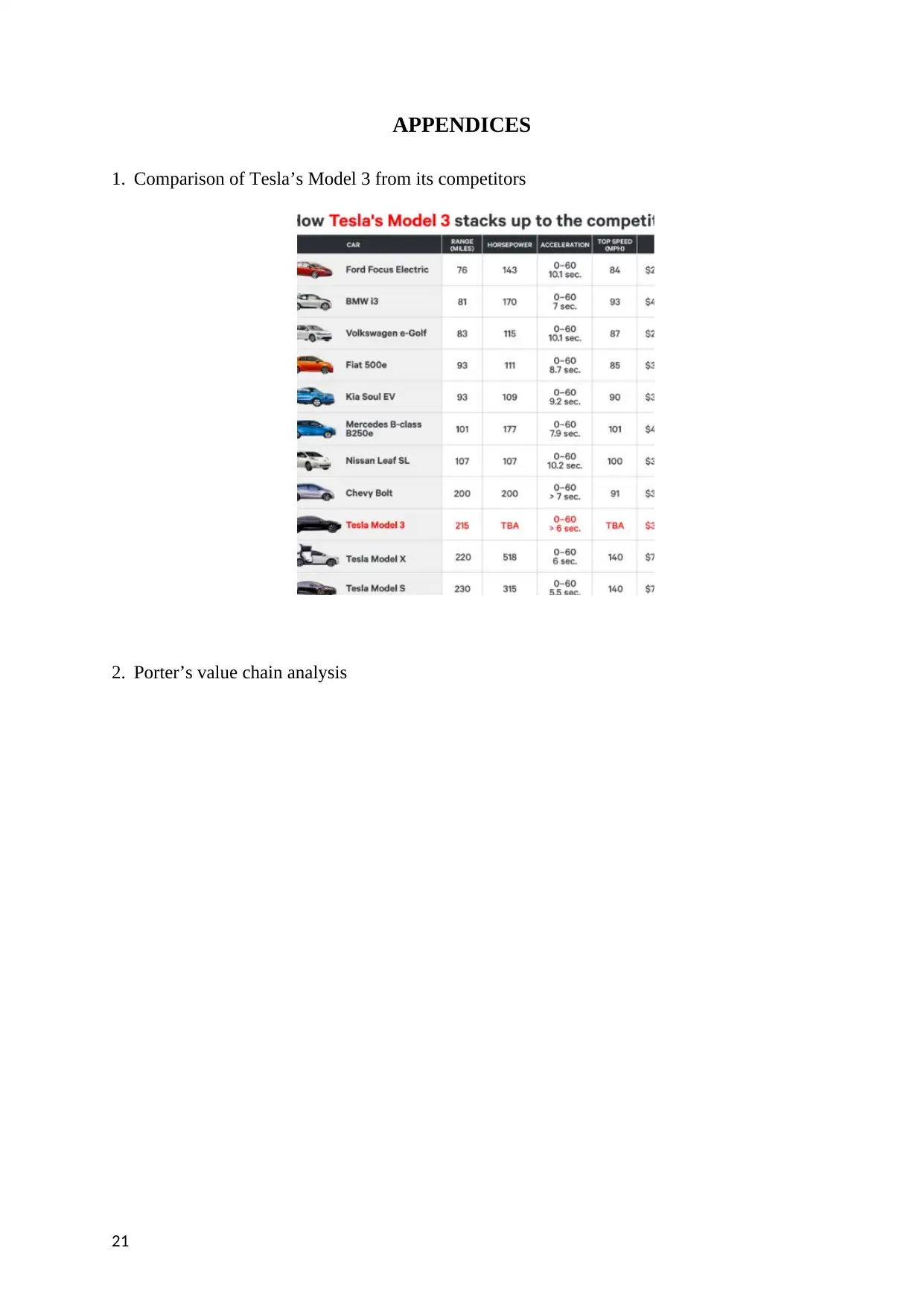
APPENDICES
1. Comparison of Tesla’s Model 3 from its competitors
2. Porter’s value chain analysis
21
1. Comparison of Tesla’s Model 3 from its competitors
2. Porter’s value chain analysis
21
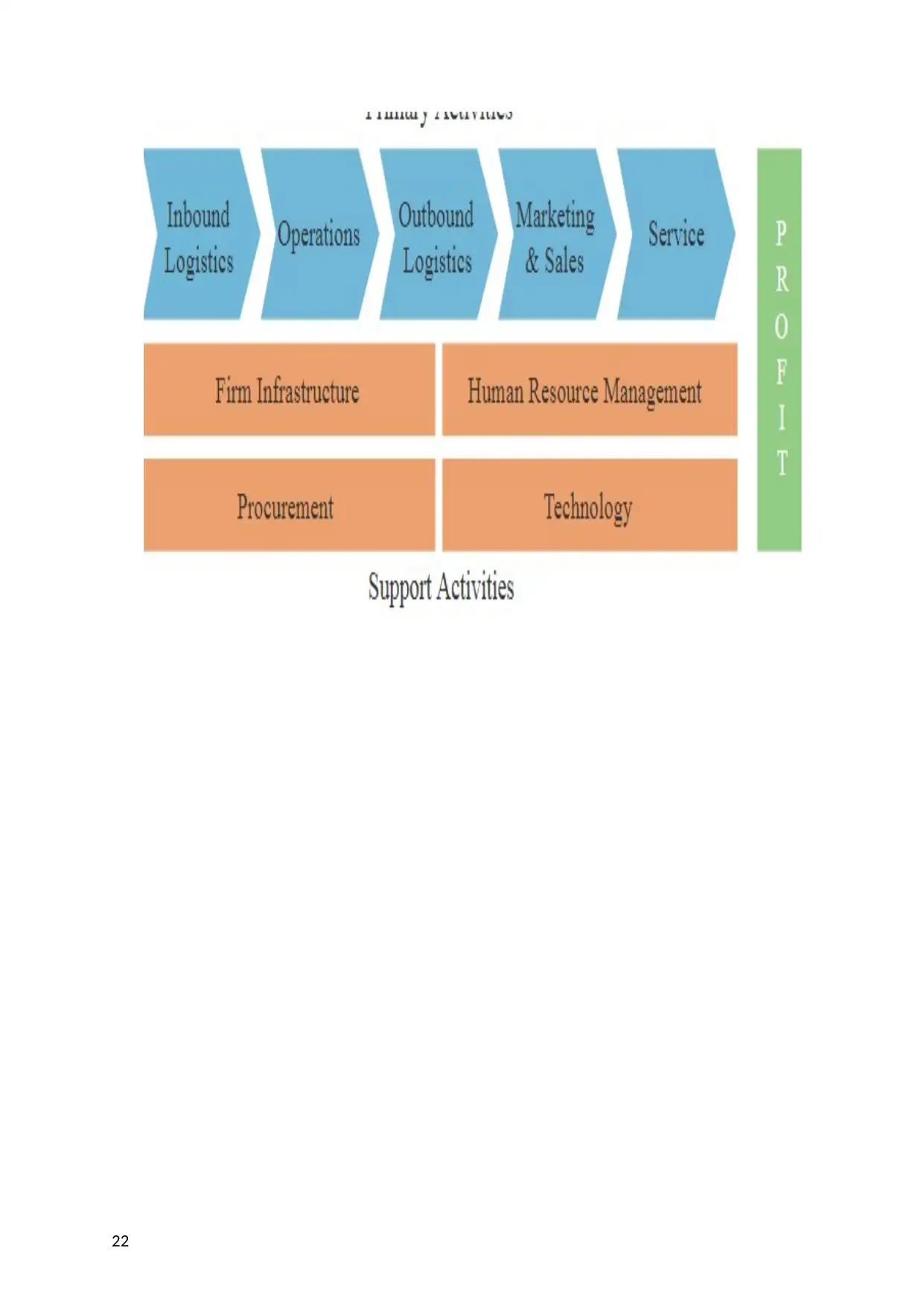
22
1 out of 22
Related Documents
Your All-in-One AI-Powered Toolkit for Academic Success.
+13062052269
info@desklib.com
Available 24*7 on WhatsApp / Email
![[object Object]](/_next/static/media/star-bottom.7253800d.svg)
Unlock your academic potential
© 2024 | Zucol Services PVT LTD | All rights reserved.





